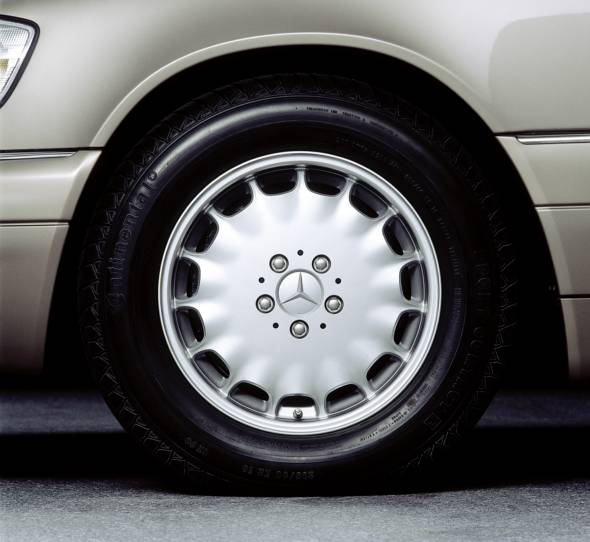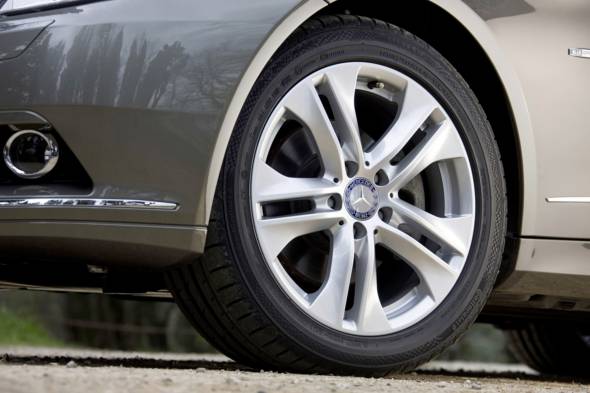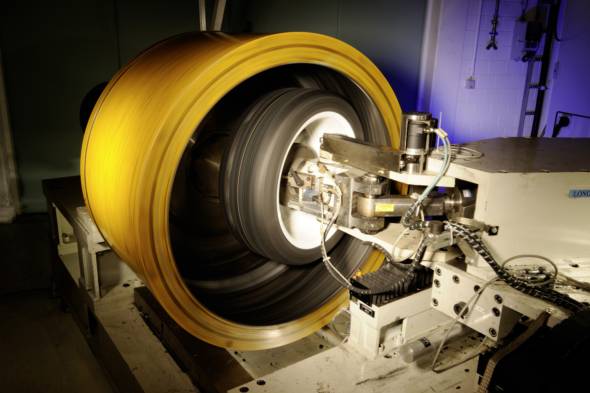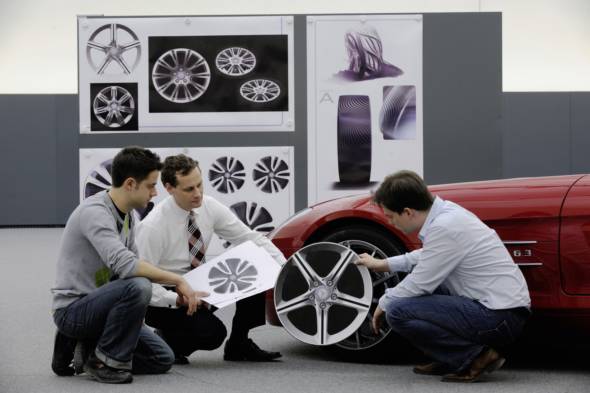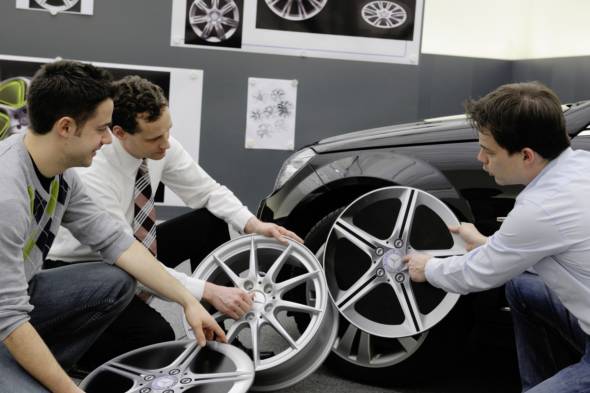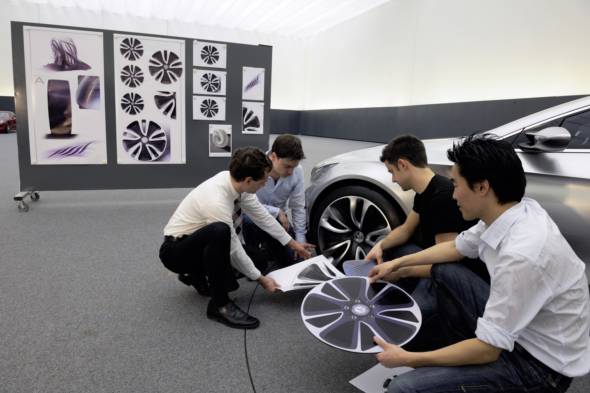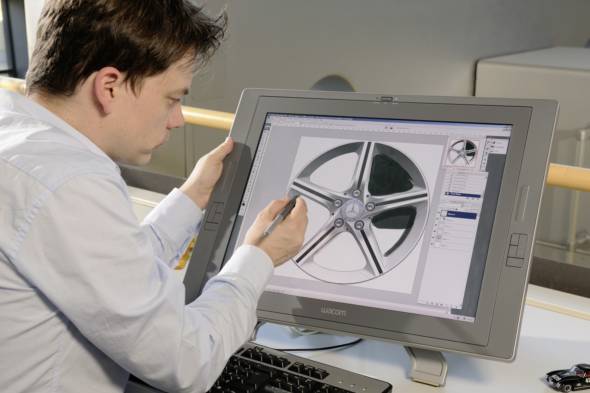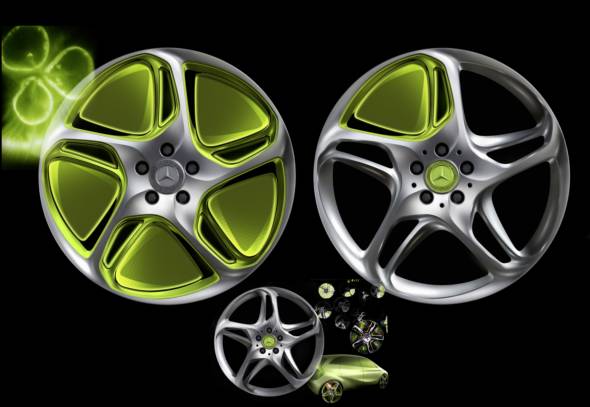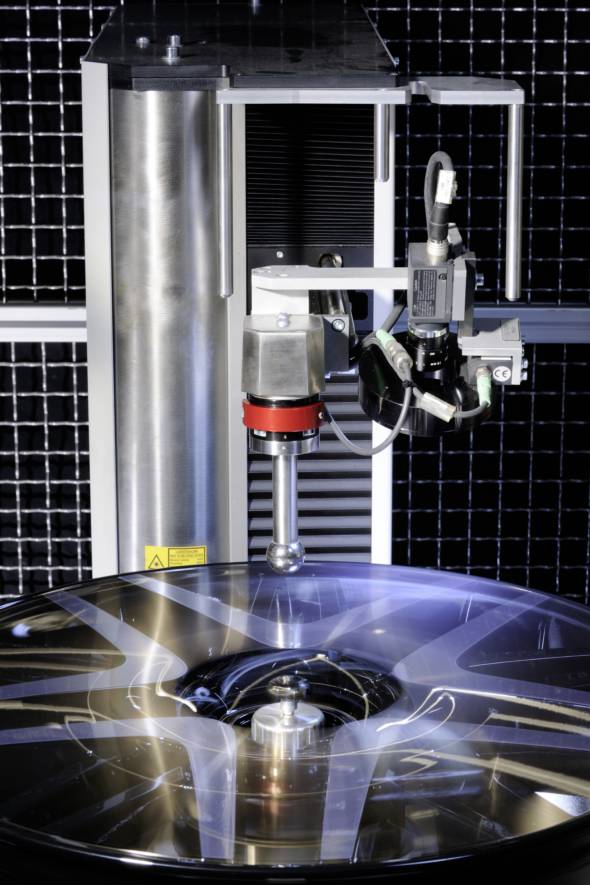Light-alloy wheels from Mercedes-Benz and Mercedes-Benz Accessories
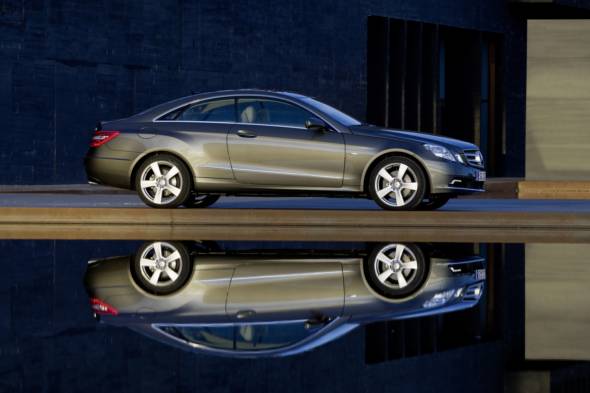
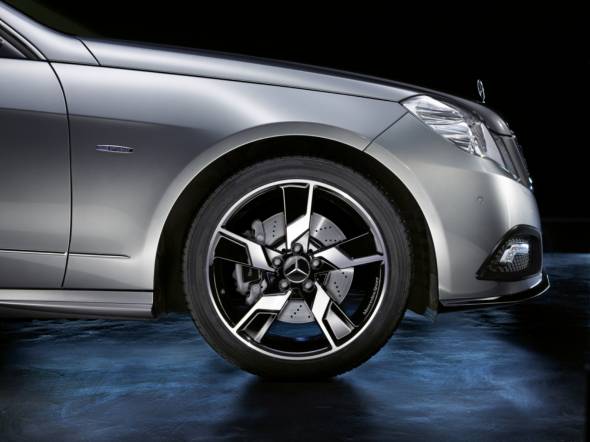
All-round success: light-alloy wheels from Mercedes-Benz
Impressive design combined with Mercedes quality
Stuttgart. Whatever model of Mercedes you may drive, Mercedes-Benz and its subsidiary Mercedes-Benz Accessories GmbH have just the right light-alloy wheel to suit every taste. When ordering a vehicle, customers can currently choose their perfect wheel from a selection of around 20 different design variations per model series, which are available either as standard or as optional extras. In addition, almost as many wheel models are also available from Mercedes-Benz Accessories for the current model range.
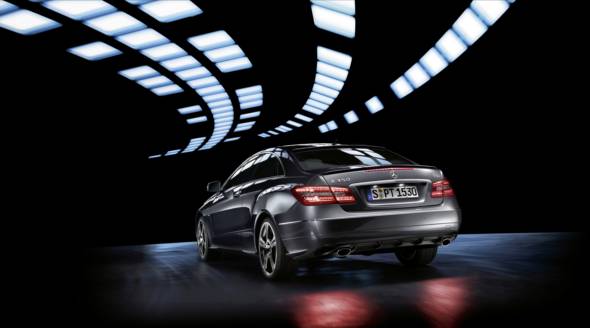
All of the light-alloy wheels on offer have to meet the same high safety standards – there is no difference whatsoever in term of quality between the models available as standard or as optional extras, or even the versions available from Mercedes-Benz Accessories. The customer always receives a product which has been opti-mally tuned for Mercedes-Benz vehicles: it will provide exemplary ride comfort and high driving dynamics, meet demanding design standards, and will also be characterised by high performance combined with an excellent service life.
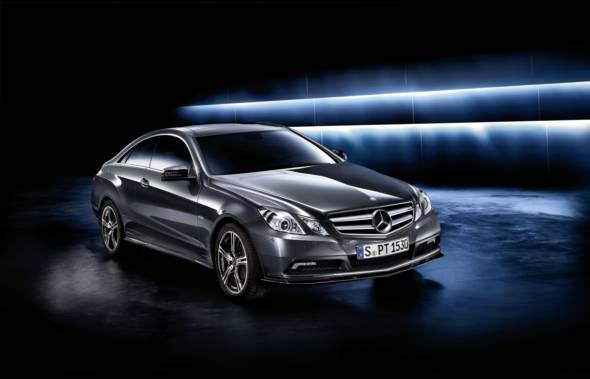
These benefits are not only the result of close collaboration between vehicle develop-ment and specialists from wheel development. Wheels which are to bear the Mercedes star must also pass a comprehensive test programme which goes far beyond the statutory requirements laid down by the German road traffic type approval law. This includes actual test procedures which are based on the harshest of operating conditions in real driving situations, as well as inspections carried out using the latest x-ray systems and computed tomography scanners.
Mercedes-Benz Accessories: high-sheen two-tone wheels top the popularity charts in spring 2010
Topping the popularity charts this spring are Mercedes-Benz wheels featuring a two-tone finish. According to the Mercedes-Benz designers, however, they are more than just a passing fad and are set to enjoy increasing popularity in the fu-ture. These high-quality wheels enjoy additional appeal thanks to the interesting contrast created between the bare-look metal surface and the dark painted areas, thus giving the vehicle an even more exclusive appearance. Mercedes-Benz Accessories is currently offering the following wheels in a high-sheen two-tone finish (as at April 2010):
40.6 cm (16 inches):
A/B-Class: 10-spoke wheel in two-tone palladium silver
43.2 cm (17 inches):
B-Class: 5-twin-spoke wheel in two-tone palladium silver
C-Class: 7-spoke Redali wheel in two-tone palladium silver
C-Class, CLC, CLK and SLK: 7-twin-spoke wheel in two-tone palladium silver
45.7 cm (18 inches):
E-Class Saloon: 5-spoke Xentres wheel in two-tone black
E-Class Coupé: 5-twin-spoke wheel in two-tone black
48.3 cm (19 inches):
SL-Class: 6-spoke Himalayas wheel in two-tone grey
GL-Class: 10-spoke wheel in two-tone black
50.8 cm (20 inches):
S and CL-Class: 5-Y-spoke Behes wheel in two-tone black
GLK: 5-twin-spoke Bigawa wheel in two-tone black
M and GL-Class: 10-spoke Tomeko wheel in two-tone black
5-twin-spoke Himalayas wheel in two-tone grey
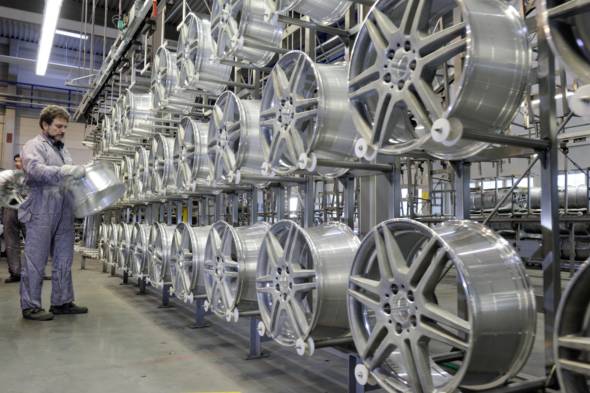
The fitting of wheels does not require any reports or Technical Inspection Asso-ciation registrations to be carried out, since all wheels form an integral part of vehicle type approval.
Wheel design: bringing everything together
Obviously without wheels a vehicle is going nowhere – this simple observation not only describes the basic technical requirement for a properly functioning motor car, but also highlights the importance of the wheel as part of a powerful vehicle design. At Mercedes-Benz, high-quality wheels which match the body-work and form a logical continuation of the design therefore play a significant role in the high design standards of the overall vehicle.
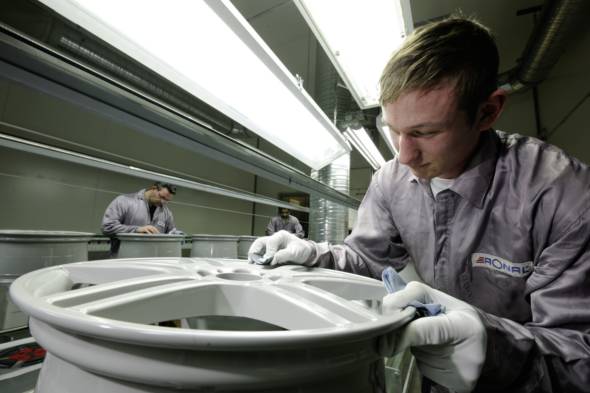
At the Mercedes-Benz design centre, light-alloy wheels available either as standard or as optional extras are designed by specialists in the area which is also responsible for creating the entire exterior form of the vehicle.
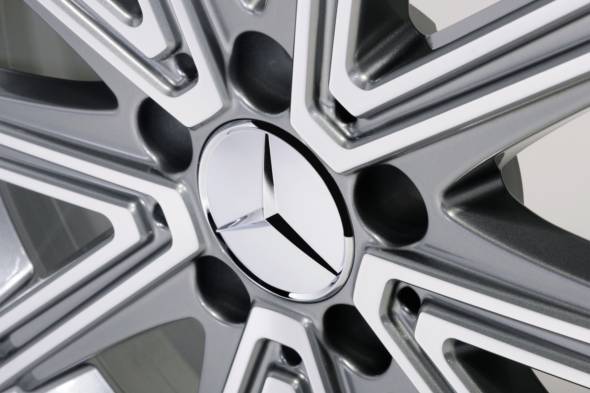
Complex test programme forms part of product development
Mercedes-Benz guarantees the quality of its new wheel models with a compre-hensive development programme. As part of this, the tests and inspections which are carried out go far beyond the statutory requirements. Even when it comes to wheel development, one basic principle is applied: in the development and testing phases, Mercedes-Benz bases its work on the actual load profile of light-alloy wheels under real operating conditions and coordinates its programme accord-ingly. As a result, light-alloy wheels bearing the Mercedes star are among the safest, best performing and most durable products on the entire automotive market.

One of the most effective test methods for assessing a new light-alloy wheel is “ZWARP”, from the German “ZWei-Axiale Räder-Prüfstand” (biaxial wheel test bench). Unlike a conventional rolling test in which the wheels run straight on an external roller with a specific ground contact force, the ZWARP uses an oversized roller to subject the wheels to both ground contact and lateral forces generated as a result of additional transverse movement of the test system. This is why it is called ZWARP (biaxial).
The test conditions are extreme: as part of the test run the wheels are subjected to a ground contact force of up to 35 kN over several thousand kilometres, which in real operating terms equates to the distance travelled over the entire service life of the vehicle. By applying steering movements, the wheel is also pressed against the side lip of the rotating drum with a lateral force of up to 25 kN, thus simulat-ing the wheel loads generated during sharp cornering. The requirement imposed by Mercedes-Benz for this marathon is that despite initial mechanical damage, the test wheel should not show signs of any cracks over the test distance. If a wheel passes the ZWARP test, based on experience it will usually last the life of the vehicle several times over under normal operating conditions.
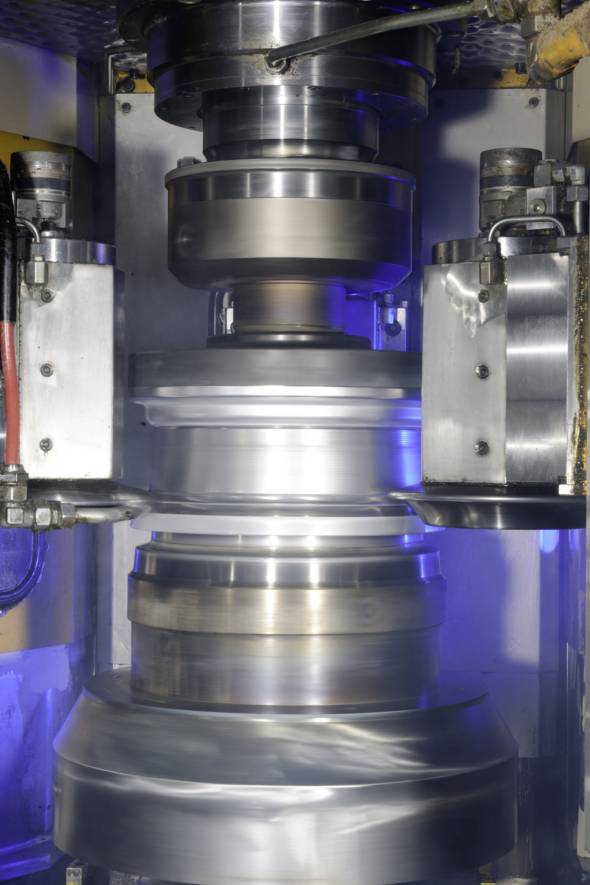
Another stress test is the rotary bending fatigue test, which subjects the wheel structure to load cycles through oscillating movements, simulating maximum cornering in which bending moments of between 1900 and 11,000 Nm are ap-plied. This test is conducted in parallel on several wheels and under different load conditions:
- 4 wheels successfully complete 200,000 load cycles with a 100% bending moment
- 4 wheels successfully complete 800,000 load cycles with a 75% bending moment – this is four times the statutory requirement
All wheels have to survive under these conditions without any cracks forming. However, the test is continued until such time as initial cracks start to appear. This has shown that light-alloy wheels from Mercedes-Benz are able to withstand several million load cycles without suffering any damage – which means they are able to last for quite a few vehicle lifetimes under normal operating conditions.
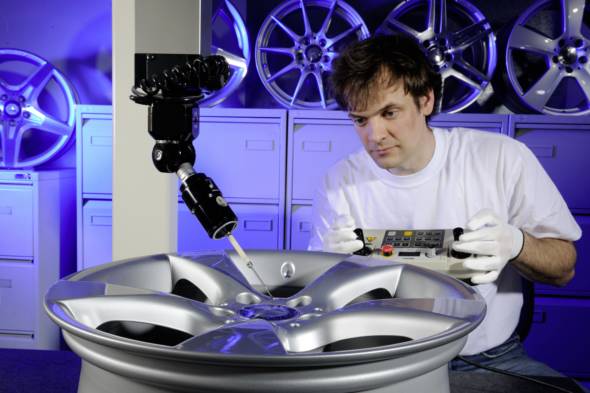
Leading role in industrial computed tomography
An important part of the development process for new light-alloy wheels are examinations which look at the internal microstructure of the wheel, right down to atom level. While the examinations conducted on the various test systems and facilities give an indication of whether the performance of a new wheel is able to meet the high standards required by Mercedes-Benz, supplementary examina-tions using reflected-light or scanning electron microscopes, and both x-ray and computed tomography systems, provide an insight into why some wheel proto-types are more resilient than others.
While it is always necessary to destroy the test wheel in order to produce samples for examination under reflected-light or scanning electron microscopes, non-destructive testing on the other hand is also used to supplement the development phase and makes an important contribution to checking subsequent series pro-duction at suppliers. The wheels are inspected at the acceptance stage using x-ray systems and examined for cavities (air pockets) and imperfections larger than 0.3 of a millimetre. If even more detailed examinations are necessary then com-puted tomography (CT) is used. This is a process used in the medical field and was introduced by Daimler AG for industrial use – the first automotive company to do so – as early as 1995. The company now plays a leading role in this field. The Stuttgart-Untertürkheim plant currently has the most modern CT system for industrial use in the world.
Unlike x-ray examination, CT produces three-dimensional images. As a result, the position and size of the slightest weak spots caused during the casting process, such as cavities or gas pockets, can be accurately determined. Used in conjunc-tion with the tests conducted on the test benches, these CT assessments provide evidence of where the smallest imperfections might have a big impact on per-formance. These component areas can then be enhanced during the technical casting and production processes. In addition, the knowledge gained can be carried over into future wheel development.
Special corrosion tests for high-sheen wheels
High-sheen light-alloy wheels require a very special paint structure which pro-vides reliable protection against corrosion for the bare-look metal surfaces.
In developing new anti-corrosion paints for high-sheen wheels, Mercedes-Benz introduced the toughest of test methods – a series of ultimate tests for wheel coatings. To begin with, staff at the corrosion test centre prepare individual wheel segments by scribing deep marks on high-sheen areas which penetrate down to the bare light alloy. These prepared wheel segments then undergo the so-called CASS test for 24 hours. In this chamber-like system, the paint finishes are per-manently subjected to different, highly-corrosive salt sprays. The next stage for the test samples is the filiform chamber. Here the test samples – now partly coated in a crust of salt from the CASS test – must withstand a 28-day variable climate programme. As part of the final evaluation, the employees assess the filiform corrosion around the scribed marks. Approval is only granted for those anti-corrosion paints which reduce undercutting corrosion to a minimum and at the same time do not negatively impact on other properties.
Around 250 wheels per year undergo this test marathon. But it is not only new wheel models which are approved on the test bench. The specialists also carry out the comprehensive test programme when a wheel supplier wants to introduce new materials, such as a base coats, clear coats, functional coatings such as anti-corrosion paints, and also primers or pre-treatments. The changes only receive a “basic material approval” once all tests have been passed without any issues. At the same time, wheels from current production are also tested to ensure that they meet strict Mercedes-Benz quality criteria.

The severity of the test series con-ducted in the climate chamber is demonstrated by the enormous amount of salt which is consumed at the corrosion test centre: the plant requires around 5 tons of salt each year. Used salt is recycled in the basement of the test facilities.
High quality from the best and most prestigious suppliers
When it comes to producing light-alloy wheels, Mercedes-Benz only trusts the world’s best and most prestigious suppliers. These companies have a high level of know-how and produce wheels in accordance with strict Mercedes specifications. Numerous test procedures, both on current production as well as in the labora-tory, help to guarantee a high standard of quality. These procedures include moni-toring the raw materials at the time of delivery and during subsequent process-ing, 100-percent x-ray examination, leakage tests, continual monitoring of strict geometric data and concentricity during machining, as well as monitoring the painting process.
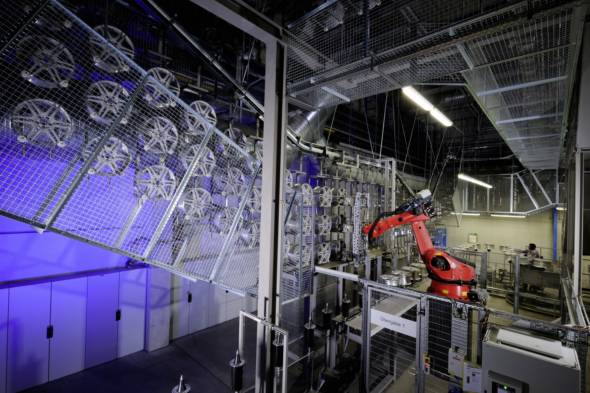
The production of two-tone wheels involves a considerable amount of additional effort since special coatings are applied to provide reliable protection against cor-rosion. After the first coating the system removes these wheels from the produc-tion process and transports them to special turning machines fitted with diamond cutting tools which remove the coating layers in specifically defined areas of the wheel – mostly on the spokes or the outer wheel rim base. This so-called “high-sheen polishing” process creates metallic high-gloss areas which contrast against the remaining coating. Of course these areas must be resealed as part of a new coating process. This has a three-layer structure: after being pretreated once more, the wheel then receives a transparent anti-corrosion coating, specially developed for Mercedes-Benz wheels, followed by various clear coatings to build up the final glossy finish.
A smooth process – flowforming
In conjunction with cast, one-piece aluminium wheels, “flowforming” is a rela-tively recent machining method. Basically wheels which have been machined using the flowforming method offer the best of both worlds. Not only does the designer retain the high degree of freedom over the design which a cast wheel provides, but a flowformed wheel also enjoys the advantages afforded by forged wheels, which are expensive and complex to produce: high strength combined with optimised component weight.
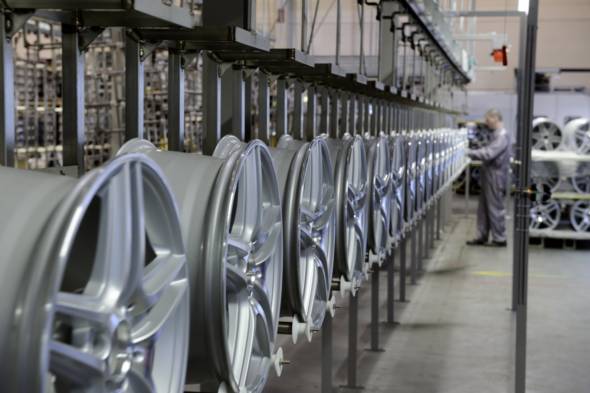
As with the wheel production process described above, first of all a blank is cast which has a very narrow wheel rim base but with significantly greater wall thickness. After being heated up to around 350 degrees, this blank is then stretched on a cylinder which tapers slightly towards a cone at the top. The blank and cylinder are rotated while three rolling heads, which are also rotating, are pressed against the blank from the outside in a downward motion and at high pressure – around 120 tons. This forces the metal into the desired shape over the cylinder, hence “flowforming”, and at the same time compresses it. A wheel rim base created in this way has a similar structure to a forged wheel, offering the highest degree of stability with the lowest possible weight. Subsequent heat treatment of the flowformed wheel then gives it its final strength.
Care tips and methods
There is one thing which the best development programme, the most innovative production technology or a perfectly tuned test programme cannot affect, how-ever: how customers treat their vehicles, and as a result their valuable light-alloy wheels. As always, how the wheels are treated has a significant influence on their value retention and also the safety of the vehicle. Here are some useful tips:
- Do not use abrasive cleaning agents. The products recommended by Mercedes-Benz will clean the wheels gently and effectively.
- Do not use rough or abrasive sponges for cleaning wheels.
- Observe the specified wheel tightening torques. Tightening the wheel bolts too much, or not enough, can damage the wheel over time.
- Do not oil or grease the wheel bolts, since the initial stress will be higher than the specified tightening torques and could damage both the wheel and the bolts.
- Use original Mercedes-Benz wheel bolts only.
- If the wheels are subjected to a heavy blow, e.g. after driving over deep pot-holes, check the wheels. If there is visible deformation you must have the dam-age checked by a dealer.
- Mechanical or thermal wheel repairs, such as welding, bending or grinding can reduce the stability of the wheel due to changing the microstructure of the metal and are therefore not permitted. Any wheels which are damaged should be exchanged!
- Only recoat scratched wheels with cold varnishes. Bake-on coatings can also change the microstructure of the metal and therefore reduce the strength of the wheel.
- Only fit tyres of the size permitted for the wheel.
- When driving with a heavy load and/or a trailer, adjust tyre pressure accord-ingly and observe the permitted wheel loads.
Legendary light-alloy wheels from Mercedes-Benz
Mercedes-Benz introduced the use of light-alloy wheels on volume produced vehicles at the start of the 1970’s, with forged aluminium wheels from well-known producer Fuchs. The “premiere wheel” was the first to be made available as an optional extra for the 280 S to 300 SEL 6.3 W 108 series Saloons, and was later christened the “baroque wheel” on account of its ornate design. After this initial foray into the world of light-alloy wheels the range continued to be ex-panded. For the 190 compact model series and models from the 200 to 300 E mid-size model series, a 20-spoke light-alloy wheel first appeared in the accessory catalogue from the mid-1980’s, which thanks to its characteristic wheel disc shape soon earned the nickname the “police star wheel”. The final triumphant move came in the same decade in the form of the legendary “manhole cover wheel” which – as its charming name already suggests – resembled a manhole cover.
Today, with a few exceptions, almost all of the series production vehicles from Mercedes-Benz run on light-alloy wheels. How successful they have been is reflected in the following comparison: around 4600 examples of the “baroque” model were sold each year. In 2009, the majority of new Mercedes-Benz vehicles were on “alloys”. Together with the sales figures from Mercedes-Benz Accessories, the number of alloy wheels brought into circulation has increased to around 4 million per year.
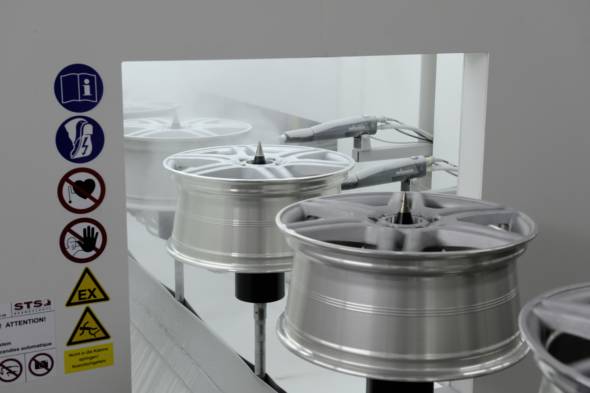
Design development
Bringing everything together
Obviously without wheels a vehicle is going nowhere – this simple observation not only describes the basic technical requirement for a properly functioning motor car, but also highlights the importance of the wheel as part of a powerful vehicle design. At Mercedes-Benz, high-quality wheels which match the body-work and form a logical continuation of the design therefore play a significant role in the high design standards of the overall vehicle. At the Mercedes-Benz design centre, light-alloy wheels available either as standard or as optional extras are designed by specialists in the area which is also responsible for creating the entire exterior form of the vehicle.
The heritage behind Mercedes-Benz wheel design
Basically all Mercedes-Benz wheels follow a specific design guideline which nevertheless gives sufficient scope for a wide variety of styles, such that indi-vidualisation options in this area are not limited. The characteristics of wheels bearing the Mercedes star primarily adhere to the principle of highlighting the vehicle design in the respective model families. To this end, the designers make particular use of sculptured, modelled areas with powerfully flowing lines, while pure, basic geometry is usually always avoided. This can also lead to completely different design approaches being adopted within a model series. Take the S-Class as an example: most customers want elegant wheels, which can result in a deli-cate, multi-spoke design on the one hand, or a generously sized and less struc-tured design on the other. Once on the vehicle, however, both solutions achieve the desired elegance. In contrast, SUV models and off-road vehicles always require striking, powerful, almost muscular wheels. For Roadsters and Coupés, the focus is squarely on sportiness. Among other things, the wheels look as big as possible thanks to maximum “connection with the outside”: for the most part the wheel spokes blend smoothly and seamlessly into the wheel rim flange. As a¨result, these models have a road stance which is powerful, almost crouching, ready for the off.
The development engineers define the design space which is available for the designers to work in. This leads to the creation of wheels which, thanks to their exceptional performance, support the high level of driving dynamics, excellent comfort and pioneering safety which are typical of Mercedes-Benz vehicles. By the same token, the designers can also work freely within the available space to come up with impressive wheel models which feature the customary high level of design quality.
A glimpse of the wheels of the future
Just like vehicle designers, wheel designers must also be able to look into the future, since due to the complex development process it can take some time before their designs actually appear on the market. But of course they are not able to use a crystal ball to help with their predictions. Research into the future and the recognition of trends is supported by Mercedes-Benz Advanced Design Studios located throughout the world, intensive customer surveys, contact with dealerships, market research and specialist agencies. These investigations have resulted in the following specific basic principles:
- The trend towards larger wheels, mounted so that they are flush with the outer edge of the vehicle body, continues to apply in all vehicle classes. This style reflects power, dynamism and driving stability.
- In the future, Mercedes-Benz customers want even higher value wheels with elaborately processed surfaces and more sophisticated colour designs.
- Mercedes-Benz and Mercedes-Benz Accessories will further expand the diversity of their product ranges from the current 130 wheel models in order to provide customers with even more individualisation options.
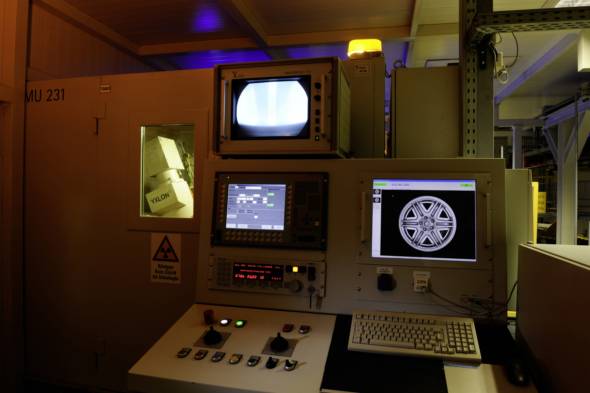
It all starts with product development
Complex programme for the best quality
Mercedes-Benz guarantees the quality of its new wheel models with a compre-hensive development programme. As part of this, the tests and inspections which are carried out go far beyond the statutory requirements. Even when it comes to wheel development, one basic principle is applied: in the development and testing phases, Mercedes-Benz bases its work on the actual load profile of light-alloy wheels under real operating conditions and coordinates its programme accord-ingly.
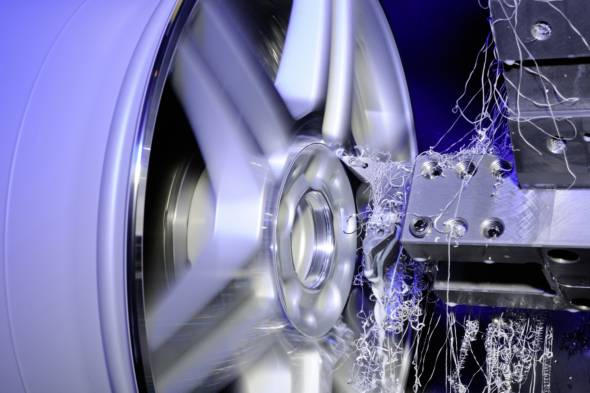
As a result, light-alloy wheels bearing the Mercedes star are among the safest, best performing and most durable products on the entire automotive market. At the same time, it is irrelevant whether we are talking about a wheel from the standard or optional ranges, or one from the wide range of accessories available from Mercedes-Benz Accessories – the process is always based on the same high standards.
Development dominated by the digital worlds
Early in the development phase of a new light-alloy wheel, engineers first specify the rough framework conditions within which to work: new wheel types for car models are determined in close cooperation with those responsible for the vehicle model series. At the same time, wheel specialists examine wheel market trends. These parameters then define the necessary wheel dimensions. The following basic principle is applied: data such as the gross axle weight, the size of the wheel well or any necessary brake clearance provide the installation space within which the designers have free space for their designs – all of course in accor-dance with exacting Mercedes-Benz design requirements. After a technical feasibility study, the final wheel design is determined.
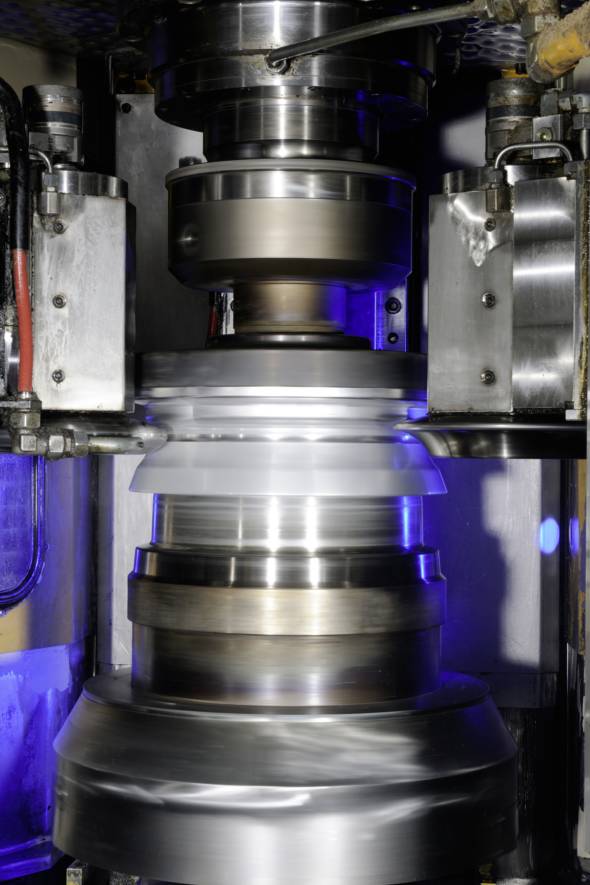
A three-dimensional volume model is then produced using modern 3D computer programs. For visualisation and discussion purposes with the development team, developers can use this model to create three-dimensional drawings, or to specify component properties such as weight, machining options in the subsequent production process, material distribution or even natural resonances and inertia moments. On the basis of these data records, the wheel is optimised with virtual test data using finite element analysis (FE analysis for short).
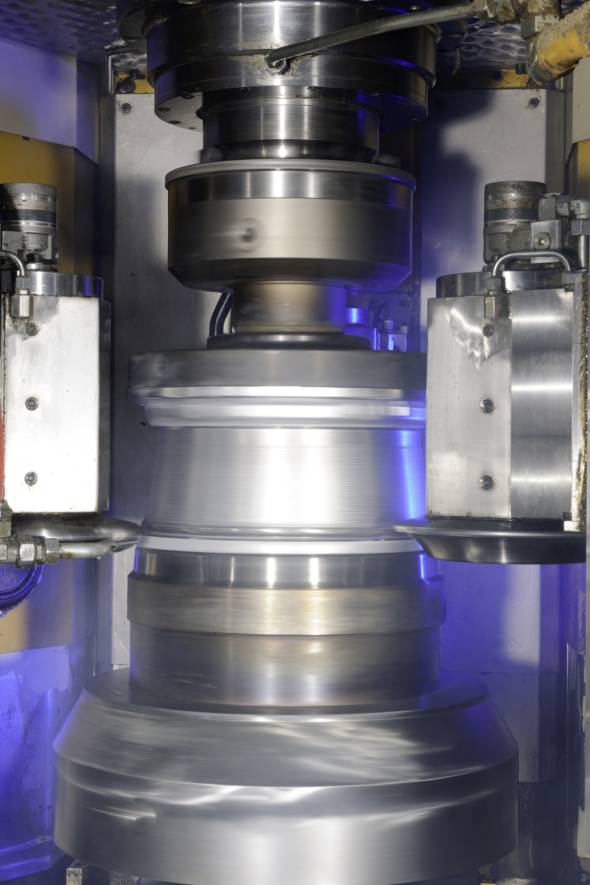
In the digital world, it is possible to simulate demanding mechanical or thermal operating conditions: for example, cornering at maximum wheel load, or driving over a pothole or the kerb, or the brake heat load generated on a long downhill stretch. As such, con-clusions can also be drawn about the subsequent production process and how it can be improved: if the intended wheel model is gravity die-cast and the material solidifies as required, will it be possible to remove the cast wheel blank from the mould without any problems? After preparing the light-alloy wheel in this virtual world, a digital mock-up is created – a computer-aided wheel model – which serves as the basis for all subsequent steps.
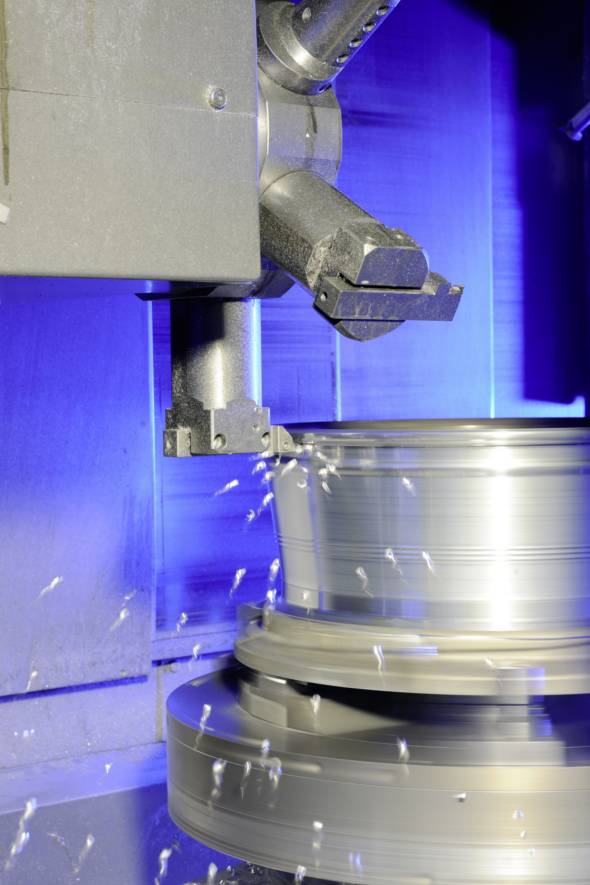
Based on the mock-up, the wheel manufacturer responsible for production sets up the necessary moulds, production tools and processes, after which the first sample wheels are produced. In this “prototype phase”, the wheel manufacturer conducts detailed examinations in cooperation with Mercedes-Benz to assess the resulting wheels and the entire production process. The objective: to optimise production at a high quality level. If this objective is reached, a true ordeal awaits the new wheels, which will be taken from the finely-tuned large-scale production test run.
In cooperation with the vehicle development divisions, aerodynamic aspects can also be incorporated into the design process. Flow simulations have shown that aerodynamically optimised light-alloy wheels and tyres can improve the overall aerodynamics of the vehicle, which in real driving conditions helps to reduce fuel consumption and can lead to a reduction in CO2 of one gram per kilometre.
“ZWARP” replaces six weeks of test driving at the Hockenheimring
One of the most effective test methods for assessing a new light-alloy wheel is “ZWARP”, from the German “ZWei-Axiale Räder-Prüfstand” (biaxial wheel test bench). Unlike a conventional rolling test in which the wheels run straight on an external roller with a specific ground contact force, the ZWARP uses an oversized roller to subject the wheels to both ground contact and lateral forces generated as a result of additional transverse movement of the test system in two directions. This is why it is called ZWARP (biaxial).
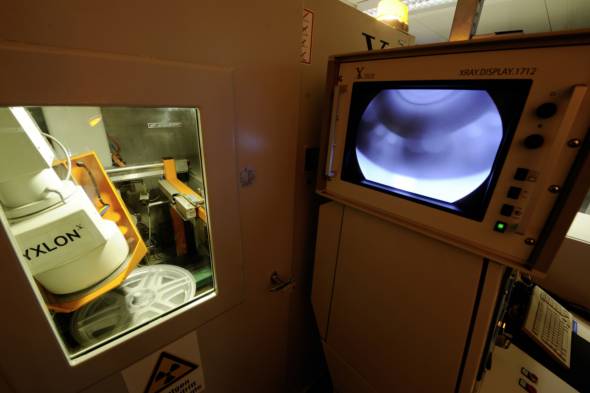
First of all the wheels are fitted with the corresponding tyre size, and to make the test conditions tougher they are initially damaged on the inner wheel rim flange by simulating driving over a kerb at 2.5 times the normal wheel load. At the same time this initial damage is also used as an individual “inner rim flange impact” test, in which deformation is not to exceed a few millimetres. Once this starting requirement is met, the actual test run takes place, divided into 22 load blocks.
The load blocks are based on the subsequent application profile of the vehicle – so according to whether the wheel is intended for a saloon, a roadster, an off-road vehicle or a people carrier. The test conditions are extreme: as part of the test run the wheels are subjected to a ground contact force of up to 35 kN over several thousand kilometres, which in real operating terms equates to the distance travelled over the entire service life of the vehicle.
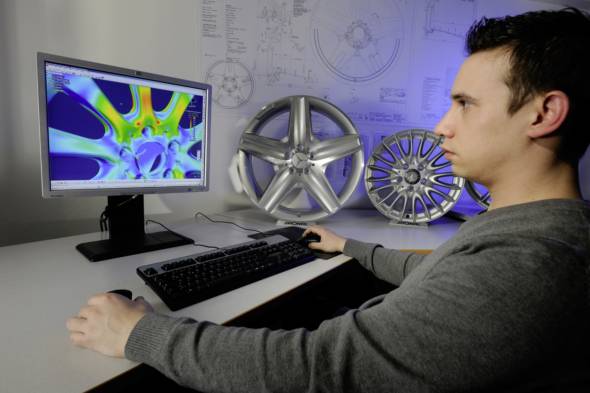
By applying steering move-ments, the wheel is also pressed against the side lip of the rotating drum with a lateral force of up to 25 kN, thus simulating the wheel loads generated during sharp cornering. The requirement imposed by Mercedes-Benz for this marathon is that despite initial mechanical damage, the test wheel should not show signs of any cracks over the test distance. If a wheel passes the ZWARP test, based on experience it will usually last the life of the vehicle several times over under normal operating conditions.
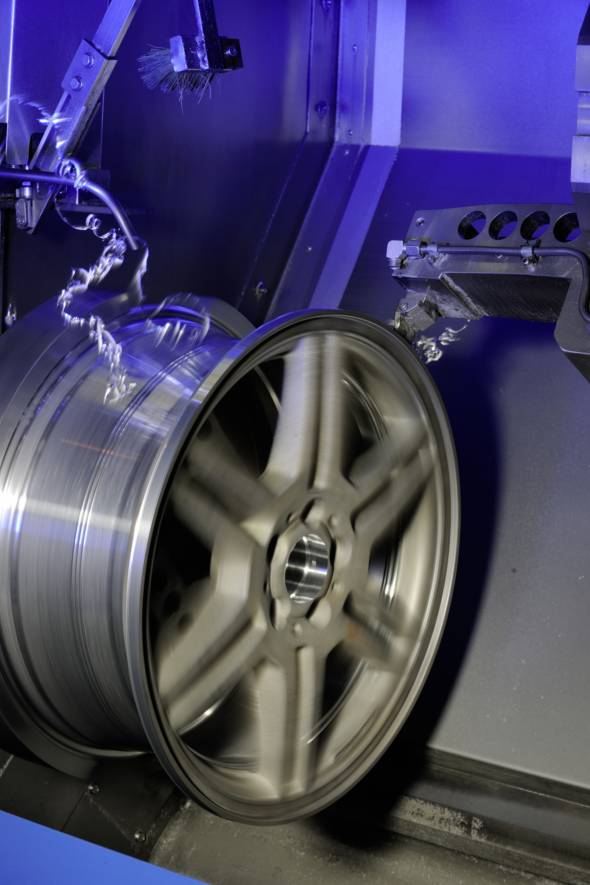
Looking back, we can now appreciate the significance of the ZWARP: previously these loads were applied to the vehicle in test drives on the race track in Hockenheim and took around six to eight weeks. At that time, together with the other tests, only around 10 light-alloy wheels could therefore be tested and finally ap-proved in a year. The ZWARP, on the other hand, is significantly more consistent over just a few days since, unlike the practical test drives in Hockenheim which were influenced by changing weather conditions, it always runs under the same, defined conditions.

Today it takes around four weeks for complete approval. In one year, therefore, the engineers and technicians can issue approvals for around 150 new light-alloy wheels. Currently, however, the test programme does not run completely without any practical tests: prototypes of new vehicle models are for the most part fitted with new wheel types for their trials and test drives. These test results are also incorporated into the assessment and approval of new types. And there is an interesting point to note here: you may not be aware but for the most part photos of prototypes therefore not only depict new vehicles, but also new wheels.
From bending to breaking: the rotary bending fatigue test
Another stress test is the rotary bending fatigue test. For this, employees clamp wheels with the inner rim side locked positively in a jig, and fix the wheel disc to a hub using the normal holes for the wheel bolts, as when fitting a wheel to a vehicle normally. This stresses the wheel structure with load cycles through oscil-lating movements, simulating maximum cornering in which bending moments of between 1900 and 11,000 Nm are applied. This test is conducted in parallel on several wheels and under different load conditions:
- 4 wheels successfully complete 200,000 load cycles with a 100% bending moment
- 4 wheels successfully complete 800,000 load cycles with a 75% bending moment – this is four times the statutory requirement
All wheels have to survive under these conditions without any cracks forming. However, the test is continued until such time as initial cracks start to appear.
This has shown that light-alloy wheels from Mercedes-Benz are able to withstand up to several million load cycles without suffering any damage – which means they are able to last for quite a few vehicle lifetimes under normal operating conditions.
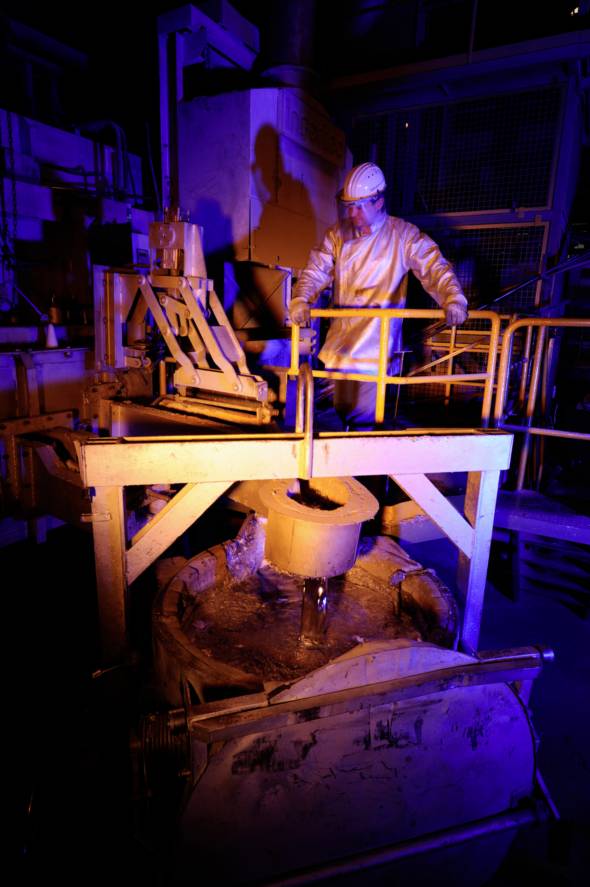
Convincing proof of stability
In addition to the inner wheel rim flange impact test forming part of the ZWARP test, light-alloy wheels aspiring to bear the Mercedes star must also withstand two further attacks. This is where, figuratively speaking, the tests turn medieval, since the wheels are placed under a type of guillotine. In the so-called impact test, which simulates driving over an obstacle such as a kerb at an angle, the wheel is fixed horizontally at a slight tilting angle under a blunt guillotine. The guillotine blade is then dropped at a weight which is calculated according to the permissible wheel load (0.6 times the wheel load plus 180 in kilograms), and from a specified height, onto the outer wheel rim flange. This not only results in an ear-deafening impact, but also in deformation of the impacted area of the wheel rim. This deformation should not exceed a specified level, and there should also be no chips or leaks. The tyre which is fitted must retain its pressure after the impact, in order to enable the vehicle to continue to be driven if this were to happen in reality.
The second guillotine process is similar, only this time the wheel is stood up vertically and the tyre tread is struck by the guillotine blade with greater force so that it goes through to the wheel rim flanges. Here too the damage must not lead to the complete failure of the wheel/tyre system.
Often underestimated: the wheel bolt connection
The importance of secure wheel bolt connection requires no further explanation. Achieving a secure connection, however, is not as simple as is generally assumed. The bolt connection system – comprising the wheel bolts, the new light-alloy wheel and the vehicle wheel hub – is therefore checked and if necessary opti-mised using a special test facility. Of key importance for correct wheel bolt con-nection is the specified torque for tightening the wheel bolts. There is a defined prestress for this, which is responsible for connecting the wheel to the vehicle.
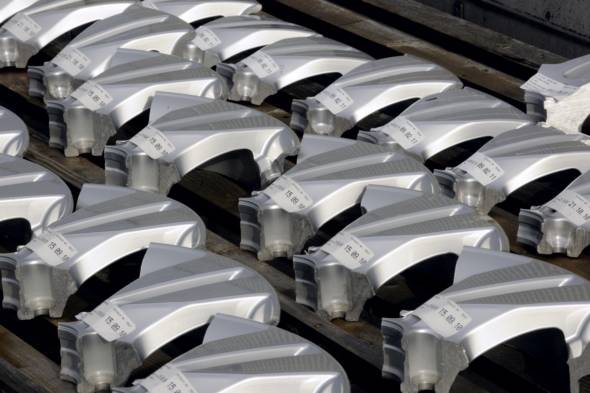
The engineers at the Mercedes Technology Centre (MTC) carry out extensive fine-tuning in this area in order to ensure that the bolt connection guarantees the highest possible level of safety. This is because prestress is influenced by a number of factors: the frictional force of the bolt thread in the wheel hub thread, the frictional force of the bolt head in the wheel crown, and the contact areas between wheel, brake disc and wheel hub.
If the frictional force of the bolt connection is too low, the wheel nut could over-stretch at the specified tightening torque due to the prestress being too high. Although it sounds ironic, these circumstances could lead to the bolt connection becoming loose. The wheel bolts should also therefore not be greased when being fitted as this could reduce the frictional force. If, in the opposite case, the fric-tional force is too high, the bolt connection would not have the necessary prestress at the specified tightening torque, and the wheel could also work loose. It is therefore absolutely vital that only original Mercedes-Benz wheel bolts are used, since they provide the optimum frictional force and therefore guarantee a secure bolt connection. Mercedes-Benz relies on the safest type of bolt connection by using wheel bolts which have a spherical crown behind the bolt head so that they fit precisely into the bolt holes of the wheel, which are also spherical. The correct prestress also supports the slightly concave contact area with which the wheel fits against the vehicle wheel hub.
Final OK after 3D measuring machine and visual inspection
The approval process for new light-alloy wheels also includes checking the geo-metric data with a 3D measuring machine using a fully automatic process. After the test wheel has been clamped in, the highly-precise system checks 20 main dimensions at 150 different points down to micro-level accuracy, and compares them against stored CAD data. Only when several wheels have also successfully passed this test within the very narrow tolerances, like all the other tests, is the Mercedes-Benz wheel development team able to carry out a final test for granting the final approval. Despite all of the technical options, these “human factor” assessments are also important. In particular, the team assesses:
- Paint quality: in addition to the tests conducted in the corrosion test centre, the paint finish is examined for its colour scheme, layer thickness, inclusions or pores. In addition, contact areas and wheel holes must be free of any paint.
- Quality of the casting: no porosity or surface cavities.
- Machining: clean deburring.
- Specified weight check.
- Correct designation.
- Trouble-free fitting of the valve and tyre pressure monitoring system sensor.
- Valve for the tyre pressure monitoring system is accessible using air refill systems normally available at filling stations.
- Hub cover fits correctly.
- Runout check.
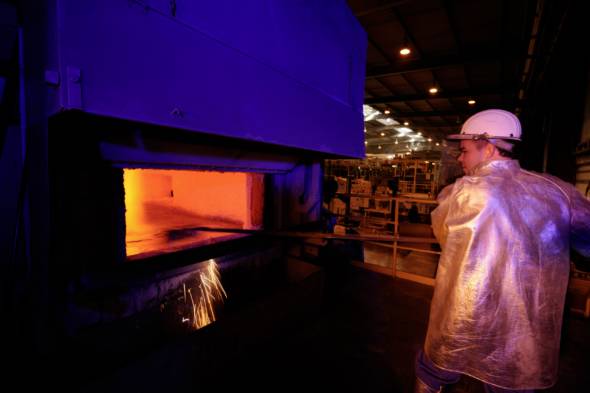
Revealing insights
X-rays, computed tomography and metallography
An important part of the development process for new light-alloy wheels are examinations which look at the internal microstructure of the wheel, right down to atom level. While the examinations conducted on the various test systems and facilities give an indication of whether the performance of a new wheel is able to meet the high standards required by Mercedes-Benz, supplementary examina-tions using reflected-light or scanning electron microscopes, and both x-ray and computed tomography systems, provide an insight into why some wheel proto-types are more resilient than others.
One example: as already described, in the rotary bending fatigue test the wheels are subjected to a load until the material breaks. This test therefore sheds light on how long a light-alloy wheel lasts under standard conditions, and provides initial indications of specific weak spots based on the position of crack initiation and the subsequent path of the fracture. What the system cannot indicate, however, is the reason for this breakage. The causes of these weak spots may be of a geometric nature, or could be down to insufficient basic properties of the material which has been used. Irregularities resulting from the casting process may also need to be taken into account. This is where the latest examination methods come into play to aid with the analysis: metal microscopy, scanning electron microscope (REM), x-ray systems and computed tomography (CT) provide detailed insights which highly-specialised engineers are able to use to optimise the wheels. Different methods are used depending on the objective of the test: while metal microscopy and the raster electron microscope (REM) can mainly be used to establish metal-lographic causes, x-ray systems and CT technology meanwhile are useful for iden-tifying cavities (voids), gas pores or foreign inclusions.
Causal investigation at micro-level resolutions
Gaining an insight into the microscopic world of a light-alloy wheel starts with the reflected-light microscope, which has a magnification ranging from 20 to 1000 times. A sample weighing just a few grams is taken from the wheel under investigation and finely ground and polished. Using a subsequent contrasting technique, the microstructure of the crystalline metal alloy is made visible. The resulting two-dimensional image of this area enables conclusions to be drawn regarding the raw material used and the processing quality during the casting process. If irregularities are revealed at this point, the wheel supplier is notified of the issue and requested to rectify it before production start-up.
After the test runs, the failure points can only be assessed under the raster elec-tron microscope because this system is able to provide a three-dimensional image at a significantly higher resolution down to micro-level (1μ = 0.001 mm). As such, the specialists at the Stuttgart-Untertürkheim plant are able analyse the failure points very precisely to determine whether the crack formation resulted from a casting flaw, or from an adverse phase formation in the metal microstructure. A crack emanating from an intact metal microstructure may indicate a structural weak spot. Once again, in such a case the relevant development areas or the supplier are notified about how these weak spots need to be eliminated.
Leading role in industrial computed tomography
While it is always necessary to destroy the test wheel in order to produce samples for examination under reflected-light or scanning electron microscopes, non-destructive testing on the other hand is also used to supplement the development phase and makes an important contribution to checking subsequent series production at suppliers. Non-destructive analysis may be necessary for example when a light-alloy wheel needs to be kept available for further tests after being examined. At the Daimler Mettingen plant, wheels are inspected at the acceptance stage using x-ray systems, and specialists use the x-ray images to identify cavities and imperfections larger than 0.3 of a millimetre.
If even more detailed non-destructive examinations are necessary then computed tomography (CT) is used. This is a process used in the medical field and was in-troduced by Daimler AG for industrial use – the first automotive company to do so – as early as 1995. The company now plays a leading role in this field. The Stuttgart-Untertürkheim plant currently has the most modern CT system for industrial use in the world. Boasting a resolution of 5 μ, this system was fully developed and independently built by Daimler, reflecting the company’s high level of competence in this field for which in the meantime it has become re-nowned throughout the entire industry. Thanks to this system, the tomography specialists have often been able to provide assistance “outside of their usual field”, for example in the case of EADS, for the optimisation of the Ariane rockets.
Unlike x-ray examination, which only provides a two-dimensional image, CT produces three-dimensional images. They are created by x-raying the wheels in layers. The three-dimensional image is generated by a computer cluster with a main memory of 54 gigabytes, using up to 2880 individual x-ray layer images of the wheel taken both horizontally and vertically by the CT system in a lead-lined room.
As a result, the position and size of weak spots caused during the casting process, such as cavities or gas pockets, can be accurately determined. Used in conjunc-tion with the tests conducted on the test benches, these CT assessments provide evidence of where the smallest imperfections might have a big impact on performance. These component areas can then be enhanced during the technical casting and production processes. In addition, the knowledge gained can be carried over into future wheel development.
Precise specifications for series production
The production and materials engineering department located at the Daimler headquarters in Stuttgart-Untertürkheim plays an important role in planning and monitoring external wheel production. The specialists who work there specify the basic metal alloys to be used, which must not only have good casting qualities but at the same time also conform to the requirements for adjusting the mechanical properties that are required. The casting process, using low-pressure gravity die casting (see section on production), must also be carried out under optimum conditions during subsequent production. Other important elements are the 100-percent x-ray test which Mercedes-Benz requires to be carried out during the ongoing production process, as well as precise heat-treatment for adjustment of the mechanical properties.
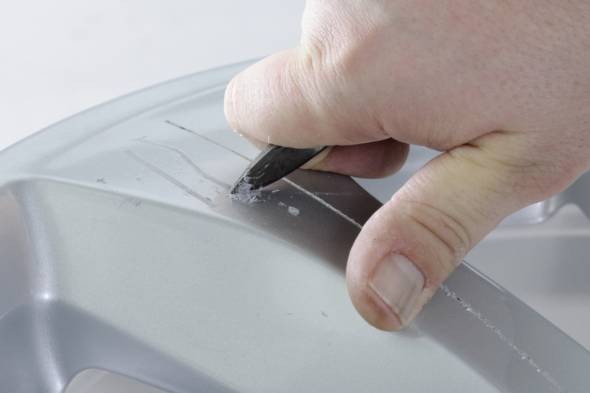
Coating systems: more than just shine
High-gloss protection all year round
In the development phase of a new light-alloy wheel, particularly high-sheen two-tone wheels, information relating to corrosion resistance is very important. This is where the staff of the corrosion test centre and those involved in paint finish development take on an important role and examine material samples or com-plete wheels under standard conditions. In addition they also check the materials and processes used in ongoing production. A whole series of effective procedures are available for this purpose.
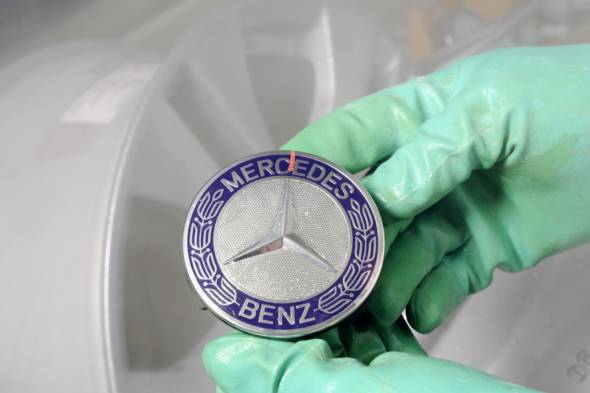
Special test series for high-sheen wheels
High-sheen light-alloy wheels require a very special paint structure which pro-vides reliable protection against corrosion for the bare-look metal surfaces. As part of the production process, first of all these wheels are completely painted. Then the paint structure is removed again in specific areas of the wheel disc, mostly the spokes, using a turning machine fitted with extremely fine machine tools.
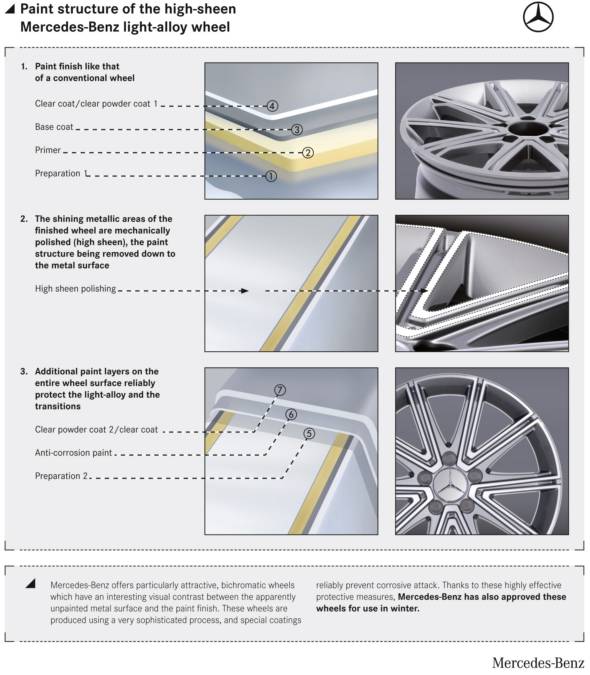
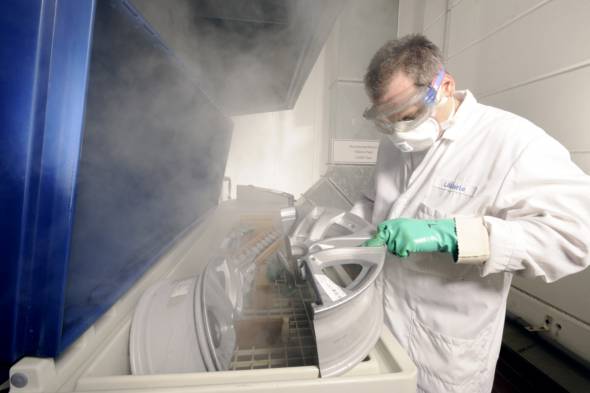
This creates a high-gloss finish on the metal surface which is then sealed again with a transparent coating in another painting process. The special appeal of such wheels lies in the contrast which is created between the coloured painted areas and the high-gloss metal surface.
Mercedes-Benz has played a decisive role in developing reliable anti-corrosion systems for high-sheen wheels and is currently considered to be a pioneer in this area. During the development phase, the staff involved in paint finish develop-ment set some challenging objectives.
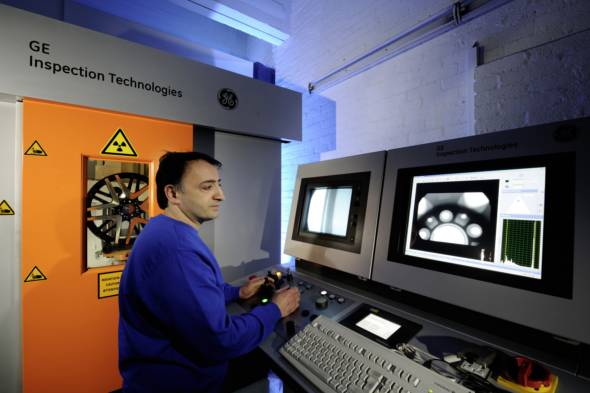
One main requirement was to find a way to reliably prevent the “filiform” corrosion which occurs in the case of high-sheen wheels – this is where the paint in the high-gloss metallic areas is initially un-dercut in a filiform manner. The filiform threads mainly follow small, microscopic score marks which are caused by the turning tool when applying the high-sheen finish.
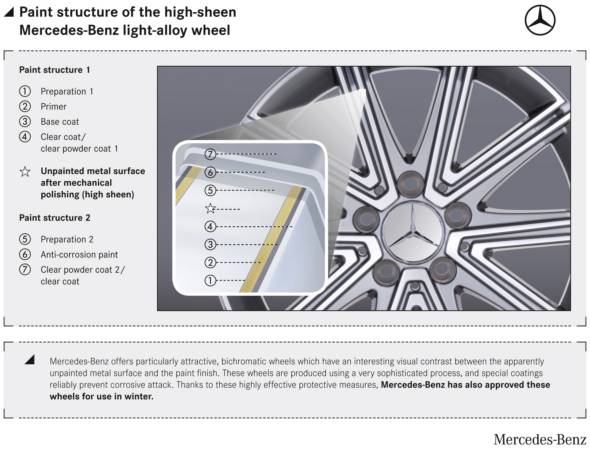
At an advanced stage, the paint layers can then become loose in parts, which results in so-called delamination. However, thanks to newly developed anti-corrosion paints which are used in the production process by all suppliers exclusively for high-sheen Mercedes-Benz wheels, filiform corrosion is now a thing of the past.
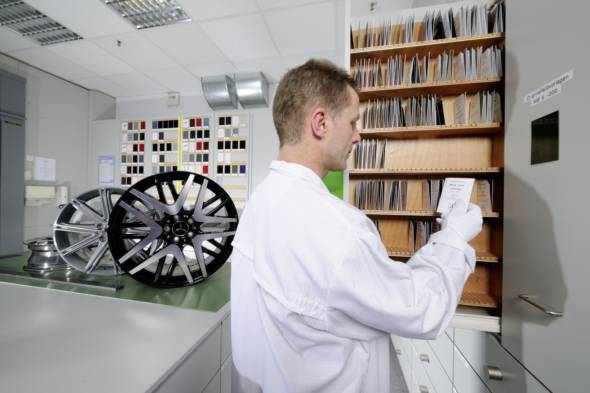
Paintwork “torture chambers” put the wheels under stress
In developing new anti-corrosion paints for high-sheen wheels, Mercedes-Benz introduced the toughest of test methods – a series of ultimate tests for wheel coatings. To begin with, staff at the corrosion test centre prepare individual wheel segments by scribing deep marks on high-sheen areas which penetrate down to the bare light alloy. These prepared wheel segments then undergo the so-called CASS test for 24 hours. In this chamber-like system, the paint finishes are per-manently subjected to different, highly-corrosive salt sprays.
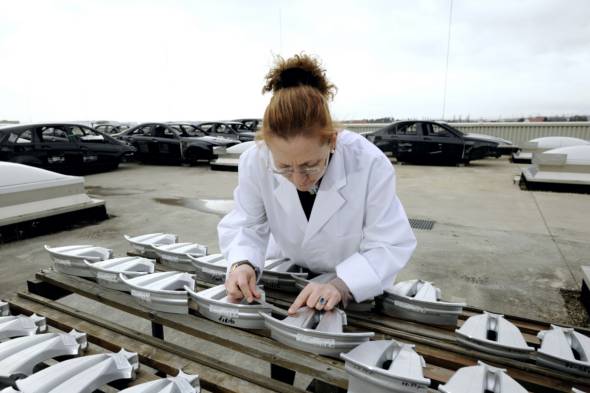
The next stage for the test samples is the filiform chamber. Here the test samples – now partly coated in a crust of salt from the CASS test – must withstand a 28-day variable climate programme. As part of the final evaluation, the employees assess the filiform corrosion around the scribed marks. Approval is only granted for those anti-corrosion paints which reduce undercutting corrosion to a minimum and at the same time do not negatively impact on other properties.
The variable climate test-D (D = Daimler), or “KWT-D” to give it its short name (after the German “Klimawechseltest-D”), is geared towards the world’s most extreme climate requirements. Individual wheels are exposed to constantly changing environmental conditions in special climate chambers. The different climate stresses are based on global weather data, meltwater analyses and data on air pollutants. The KWT-D models different climate zones.
For example, a hot/humid phase has therefore been incorporated to simulate a tropical climate, and a cold phase to simulate cold countries. The different humidity and climate variations simulate everyday motoring, such as the condensation of the morning, or the dryness of the afternoon. In addition, the test wheel is sprayed four times a week with a salt solution, so as to initiate and increase the corrosive stresses. The KWT-D subjects the anti-corrosion materials used in the light-alloy wheels to significantly higher stresses than the variable climate test specified by the VDA (Association of German Automobile Manufacturers) and also does not take as long to complete.
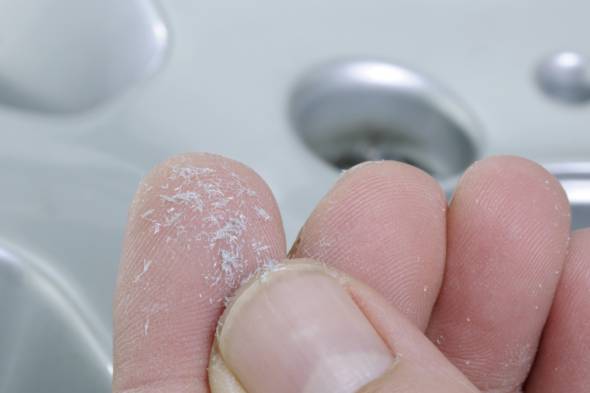
More test sequences can therefore be carried out in the same time-frame. Ultimately, customers in countries which do not push the anti-corrosion system to its limits also benefit from this stress marathon and the enhanced protection measures which are designed as a result. This is because there is no difference between the wheels supplied in regions with extreme climates or those supplied to the domestic market.
Laboratory tests examine paint finish resilience
To supplement the variable climate test-D, and also the CASS and filiform tests, the laboratories also carry out the widest variety of stone chip, scribe and scratch tests, or a steam-jet test, examine resistance to low temperatures and at the same time assess the mechanical resistance of the paint finish under standard labora-tory conditions. In addition, samples which have been initially damaged in this way can also be subjected to aggressive corrosion stresses. These series of tests help the laboratory technicians to assess the undercutting caused to the paint layers by corrosion on conventional painted wheels too.
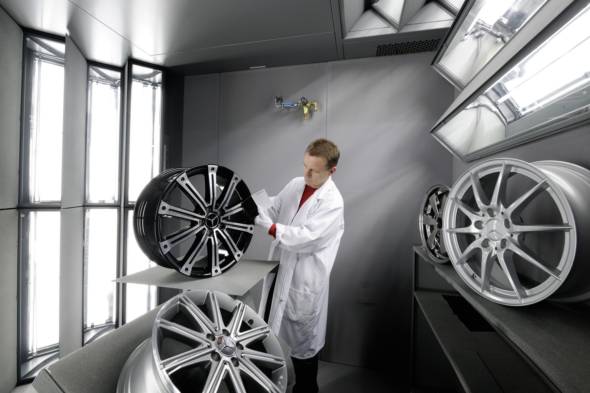
The practical experience of the staff also plays an extremely important role in all of the assessment techniques and laboratory analyses. Long-serving members of the Mercedes corrosion test centre are able to “feel” the quality of a paint finish quickly and accurately. To do this, they use a knife to scratch a small paint sample off and rub the material between their fingers. The consistency and spe-cific resistance of the paint sample give them an initial impression of the quality of the paint finish.
Colour specialists, meanwhile, assess attainment of the colour and the shine of the paint finish in their own special light cabins which maintain constant colour temperature and light intensity. To help them with their task, they also have access to a comprehensive archive of paint sample cards.
Practical test on the roofs of the production facilities
As part of the “outdoor exposure” test series, wheels are extracted from the current production process as well as from operational trials on new paints and are then prepared for a special long-term test. After staff have conducted a de-tailed quality check of the paint finish, the painted surface is subjected to initial damage by scribing deep marks in specifically defined areas which penetrate down to the light alloy. The wheel sections which have been prepared in this way spend the next year on the roof of one of the production facilities, where they have to withstand the natural environmental conditions of the Swabian town of Sindelfingen as well as additional regular salt spray attacks by one of the staff members. This series of tests is carried out on all light-alloy wheels and supple-ments the comprehensive test programme conducted in the laboratories.
250 wheel models pass through the corrosion test centre each year
Around 250 wheels per year undergo this test marathon. But it is not only new wheel models which are approved on the test bench. The specialists also carry out the comprehensive test programme when a wheel supplier wants to introduce new materials, such as a base coats, clear coats, functional coatings such as anti-corrosion paints, and also primers or pre-treatments. The changes only receive a “basic material approval” once all tests have been passed without any issues. At the same time, wheels from current production are also tested to ensure that they meet strict Mercedes-Benz quality criteria. The severity of the test series con-ducted in the climate chamber is demonstrated by the enormous amount of salt which is consumed at the corrosion test centre: the plant requires around 5 tons of salt each year. Used salt is recycled in the basement of the test facilities.
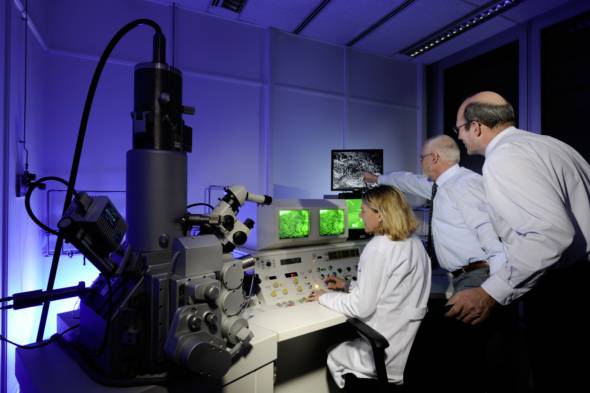
Production: the best quality from excellent suppliers
Following strict Mercedes-Benz guidelines
When it comes to producing light-alloy wheels, Mercedes-Benz only trusts the world’s best and most prestigious suppliers. These companies have a high level of know-how and produce wheels in accordance with strict Mercedes specifications. Numerous test procedures, both on current production as well as in the labora-tory, help to guarantee a high standard of quality.
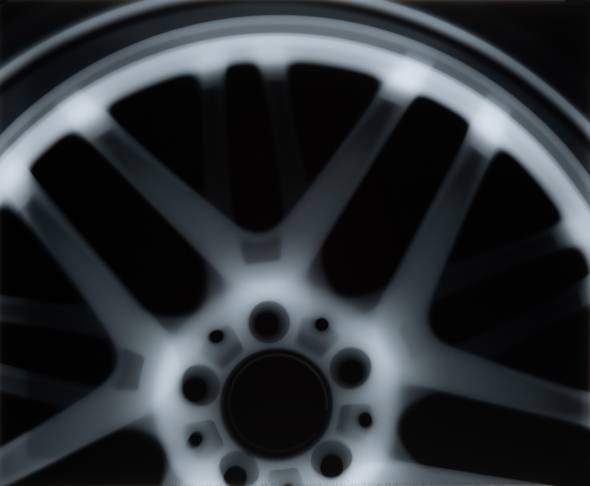
These procedures include moni-toring the raw materials at the time of delivery and during subsequent process-ing, 100-percent x-ray examination, leakage tests, continual monitoring of strict geometric data and concentricity during machining, as well as monitoring the painting process. Just how wheels are produced in accordance with the high quality standards demanded by Mercedes-Benz is best described by looking at one such supplier as an example.
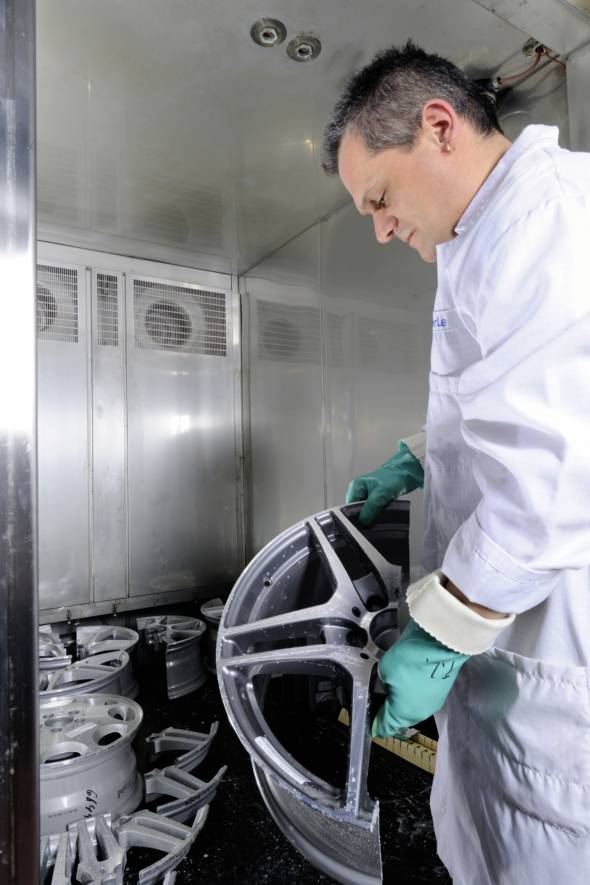
The process initially heats up in the casting facility
Primary alloys are always used as the basic raw material for light-alloy wheels, supplemented with metal waste from the company’s own production processes, such as machining shavings and defective wheels from current production. The roaring fires of the furnaces must be maintained within a narrow temperature margin of around 775 degrees. After tapping the molten aluminium alloy and subsequent cleaning of the melted mass with special additives, workers transport the so-called transport pan to the actual casting machines into which they trans-fer the molten metal.
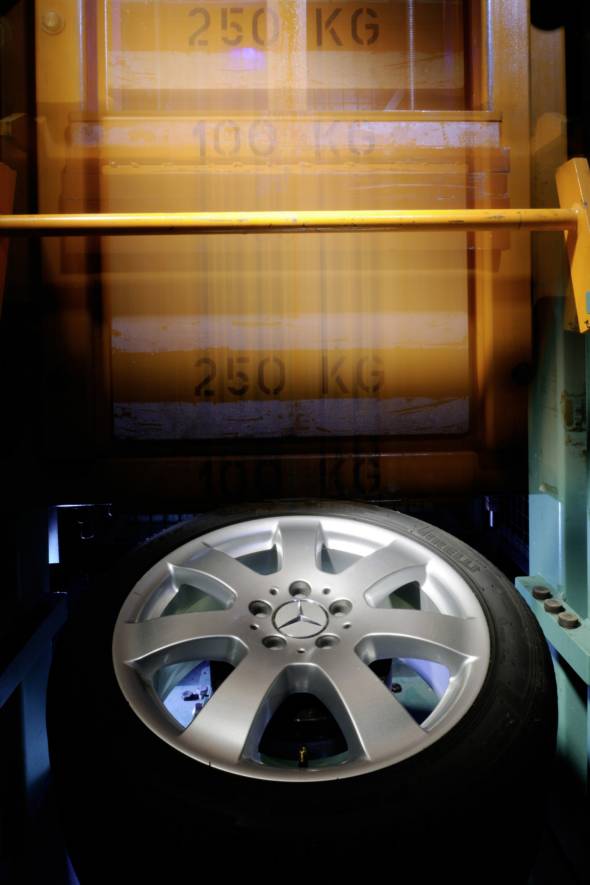
Aluminium cast wheels for Mercedes-Benz are produced exclusively using the low-pressure gravity die casting process. This works similar to a traditional espresso maker which is placed on a hotplate, in which excess pressure in the lower container forces the liquid into the top through a rising pipe. In the case of the espresso maker, it is water which flows into the upper container through the filter, but in the case of the casting machine it is the molten aluminium mass which is forced into the upper mould.
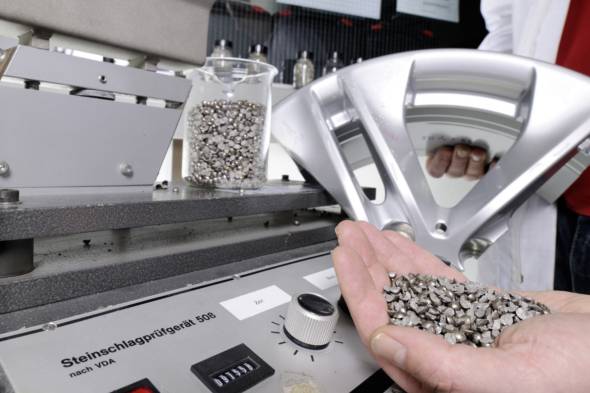
Here too the temperature must be main-tained within a narrow margin, so that the metal can flow through the mould and solidify in a precisely defined sequence. Both casting properties and the solidifi-cation process are accurately simulated during the development phase of a new wheel. After solidification, the multipiece mould is opened and the wheel blank is moved on to the next stage in a fully automated process.
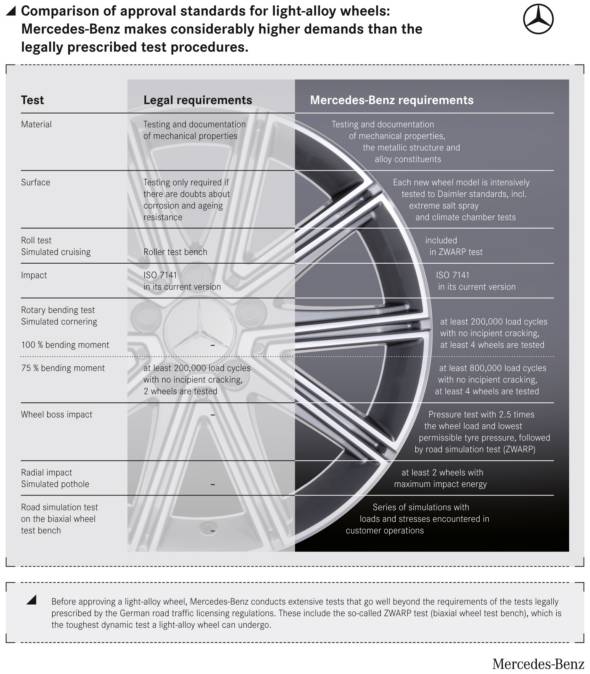
100-percent x-ray inspection during ongoing production
After casting, all of the wheels pass through a fully automatic x-ray facility. This system screens the untreated blanks in sealed chambers and analyses the result-ing images in real time. Casting defects such as cavities (air pockets) or pores which may lead to reduced stability of the wheel are reliably identified. Any wheels affected by such issues are removed from the plant and these parts are subsequently melted down again.
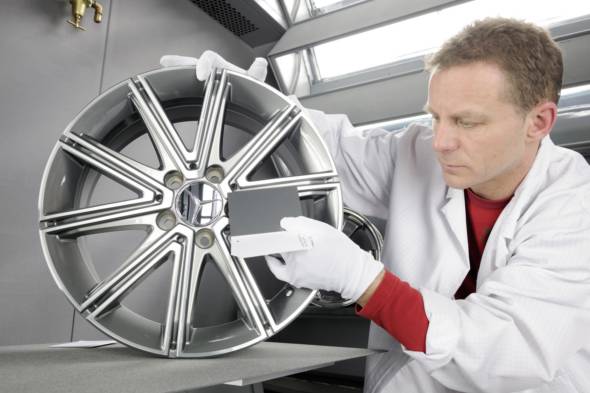
Mercedes-Benz wheels are produced exclusively from warm-stored Gk-AlSi7 aluminium alloy. This material attains its exceptionally high stability by means of a three-stage heat treatment process which follows the casting process. Prior to quenching in the water bath, the wheel blanks are first brought to a temperature of around 530 degrees for “solution annealing”, followed by warm storage for several hours at around 150 degrees. Thanks to this process the aluminium is able to achieve its final strength.
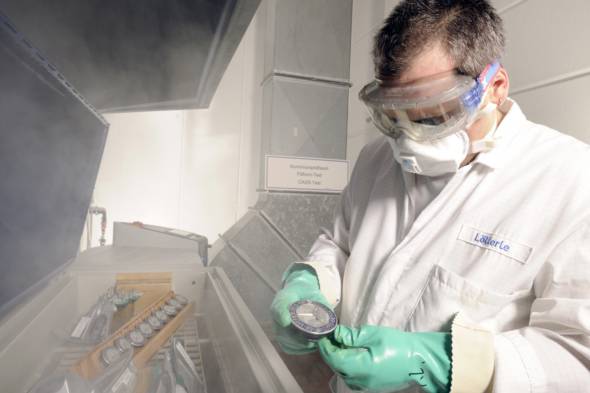
A smooth process – flowforming
In conjunction with cast, one-piece aluminium wheels, “flowforming” is a rela-tively recent machining method. Basically wheels which have been machined using the flowforming method offer the best of both worlds. Not only does the designer retain the high degree of freedom over the design which a cast wheel provides, but a flowformed wheel also enjoys the advantages afforded by forged wheels, which are expensive and complex to produce: high strength combined with optimised component weight.
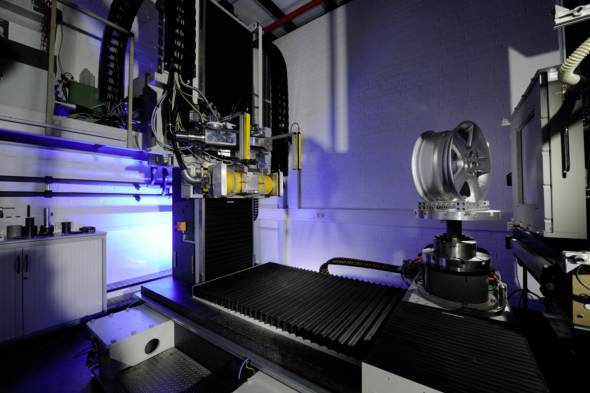
The flowforming production process: as with the wheel production process de-scribed above, first of all a blank is cast which has a very narrow wheel rim base but with significantly greater wall thickness. After being heated up to around 350 degrees, this blank is then stretched on a cylinder which tapers slightly towards a cone at the top.
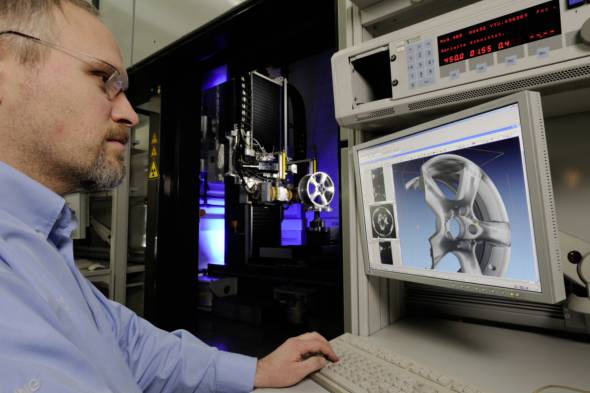
The blank and cylinder are rotated while three rolling heads, which are also rotating, are pressed against the blank from the outside in a downward motion and at high pressure – around 120 tons. This forces the metal into the desired shape over the cylinder, hence “flowforming”, and at the same time compresses it. A wheel rim base created in this way has a similar structure to a forged wheel, offering the highest degree of stability with the lowest possible weight. Subsequent heat treatment of the flowformed wheel then gives it its final strength.
Perfectly formed: machining
All wheel blanks are subsequently transformed into their final form by means of several machining stages. In this production area, where the production process now calls for reliable dimensional accuracy and a high degree of precision, only computer-controlled mechanical treatment machinery is used which achieves production tolerances of a few hundredths of a millimetre. The following areas of the wheels are worked into shape here in turning, milling and drilling centres:
- Wheel rim base; the part of the wheel on which the tyre subsequently sits
- Outer rim flange; end profile around the circumference of the wheel
- Wheel contact surface; this is where the wheel contacts the wheel hub of the vehicle
- Centre alignment; the correct dimension guarantees that the wheel sits centrally on the wheel hub
- Clamp terminal; groove in the centre alignment into which the hub cover is subsequently inserted
- Wheel bolt holes; all Mercedes-Benz wheels have a spherical contact area (hemispherical crown) between the wheel hole and wheel bolt head
- Valve hole; precise alignment is extremely important for the tyre pressure monitoring sensors, which are fitted with the valve
- The so-called “brake contour” on the inner side of the wheel disc and the rim, which guarantees the necessary clearance for the braking system.
Integrated measuring equipment in the individual production centres monitors the quality of the machining during the ongoing production process. If a particu-lar machining step comes close to the strict tolerance limits, the machine corrects itself automatically. In addition, Mercedes-Benz demands 100-percent independ-ent checks: as such, the centre alignment is measured separately while another measuring station reliably detects unacceptable imbalances.
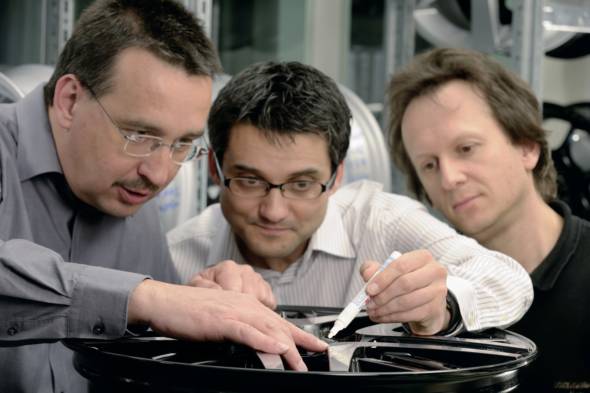
In the last test run before reaching the paintshop, all of the wheels are subjected to an automated leak test. In this test the wheel is clamped between two rubber-coated steel plates and pressurised with the inert gas helium. Helium detectors outside the wheel are able to pick up the smallest quantities of escaping gas and are therefore able to reliably detect any leaks. Any wheels which fail the test are removed from the production process. Since inert gas has a significantly smaller molecular structure than air, even the smallest of leaks can be reliably detected.
Brilliant results in the paintshop
In the first stage carried out by the paintshop production department, the wheels are put through a huge washing machine which is almost a hundred metres long. This is where the wheels are washed and degreased. After this, a base coating is applied which acts as a bonding agent between the bare metal and the subse-quent coat and at the same time also provides initial protection against corrosion.
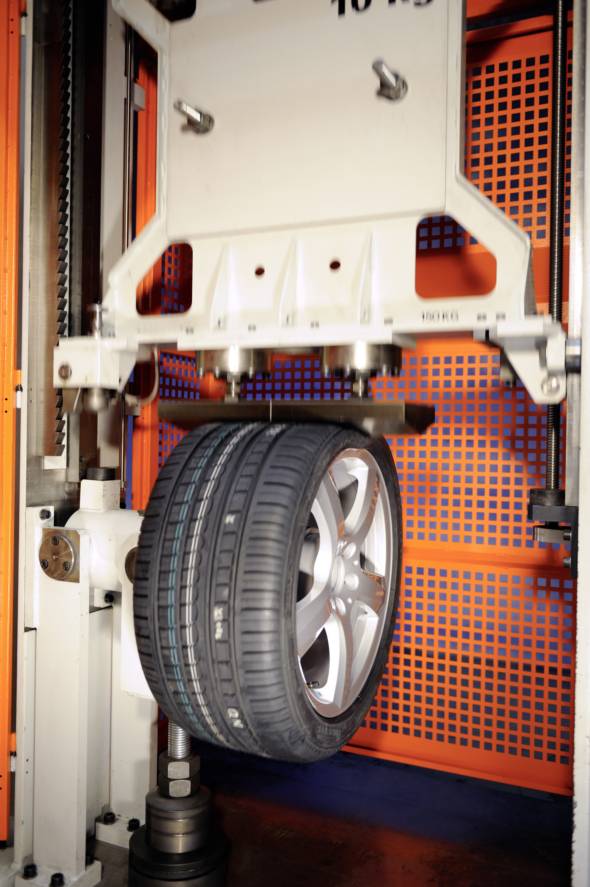
The next powder coating, applied electrostatically, is baked on in an oven and is the thickest layer applied to the wheels. It helps to even out any slight roughness of the wheel surface. Next, specially trained staff members use their fine touch in special light boxes to check the results of the first coat and correct any uneven-ness. If it is not possible to do this then any wheels which are below standard are removed from the production process. Painting robots then apply the coloured base coat in clean-room conditions and – as a final sealer – the clear coat. The wheels are then approved for dispatch in a final test station.
Machine turning for two-tone wheels
Mercedes-Benz and Mercedes-Benz Accessories offer particularly attractive two-tone wheels which feature an interesting contrast between the bare-look metal areas and the paint finish. The production of these wheels requires a considerable amount of additional effort since special coatings are applied to provide reliable protection against corrosion.
After applying the coating described above, the system removes these wheels from the production process and transports them to special turning machines fitted with diamond cutting tools which remove the coating layers in specifically defined areas of the wheel – mostly on the spokes or the outer wheel rim base. This so-called “high-sheen polishing” process creates metallic high-gloss areas which contrast against the remaining coating. Of course these areas must be resealed as part of a new coating process. This has a three-layer structure: after being pretreated once more, the wheel then receives a transparent anti-corrosion coating, specially developed for Mercedes-Benz wheels, followed by various clear coatings to build up the final glossy finish.
The steps involved in producing high-sheen two-tone wheels are as follows:
In-process inspection in the works laboratories
The ongoing production process is of course also precisely monitored in the manufacturer’s laboratories in accordance with Mercedes-Benz specifications. The examinations carried out by the laboratory technicians include the following:
- Incoming inspection of the supplied raw material, GK-AlSi7, in a spectrometer
- Tensile strength test using specially prepared wheel samples
- Microscopic examination of the metal microstructure of the finished light-alloy wheel
- Inspection of the dimensions in a 3D measuring machine
Direct involvement of the laboratory in the production process and standardised communication strategies enable any production issues to be quickly corrected if necessary.
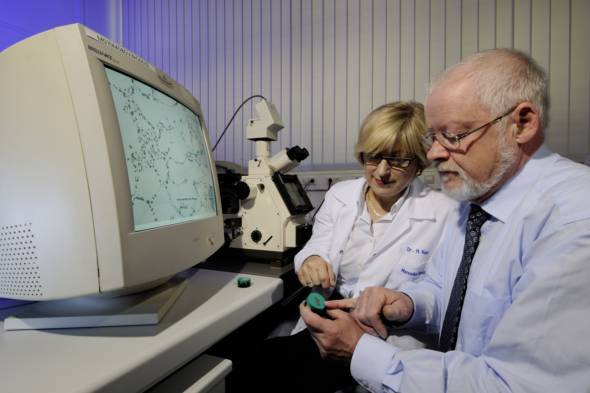
A diverse range from Mercedes-Benz and Mercedes-Benz Accessories
In a class of their own
Whatever model of Mercedes you may drive, Mercedes-Benz and its subsidiary Mercedes-Benz Accessories GmbH have just the right light-alloy wheel to suit every taste. Customers can currently choose their perfect wheel from a selection of around 120 different design variations from Mercedes-Benz Accessories (MBA). All of the light-alloy wheels on offer have to meet the same high safety standards – there is no such thing as a difference in quality between the models available as standard or as optional extras, and the versions available from MBA. In all cases the customer receives a product which has been optimally tuned for Mercedes-Benz vehicles, which provides exemplary ride comfort and high driving dynamics, meets demanding design standards and is also characterised by an excellent ser-vice life. In addition, the fitting of wheels does not require any reports or Technical Inspection Association registrations to be carried out, since all wheels form an integral part of vehicle type approval. These benefits are primarily a result of a close, early cooperation between the various vehicle production departments and the wheel specialists.
Mercedes-Benz Accessories: high-sheen two-tone wheels top the popularity charts in spring 2010
Topping the most-wanted list this spring are Mercedes-Benz wheels featuring a two-tone finish. According to the Mercedes-Benz designers, however, they are more than just a passing fad and are set to enjoy increasing popularity in the fu-ture. These high-quality wheels enjoy additional appeal thanks to the interesting contrast created between the bare-look metal surface and the dark painted areas, thus giving the vehicle an even more exclusive appearance. Mercedes-Benz Accessories is currently offering the following wheels in a high-sheen two-tone finish (as at April 2010):
40.6 cm (16 inches):
A/B-Class: 10-spoke wheel in two-tone palladium silver
43.2 cm (17 inches):
B-Class: 5-twin-spoke wheel in two-tone palladium silver
C-Class: 7-spoke Redali wheel in two-tone palladium silver
C-Class, CLC, CLK and SLK: 7-twin-spoke wheel in two-tone palladium silver
45.7 cm (18 inches):
E-Class Saloon: 5-spoke Xentres wheel in two-tone black
E-Class Coupé: 5-twin-spoke wheel in two-tone black
48.3 cm (19 inches):
SL-Class: 6-spoke Himalayas wheel in two-tone grey
GL-Class: 10-spoke wheel in two-tone black
50.8 cm (20 inches):
S and CL-Class: 5-Y-spoke Behes wheel in two-tone black
GLK-Class: 5-twin-spoke Bigawa wheel in two-tone black
M and GL-Class: 10-spoke Tomeko wheel in two-tone black
5-twin-spoke Himalayas wheel in two-tone grey
Detailed perfection
On high-sheen two-tone wheels in particular, matching wheel hub covers are an additional detail which can help to guarantee a perfect appearance. The black look with chrome star is an ideal match for the design of two-tone wheels. Suitable hub covers are also available for other wheel colours. Owners with an eye for detail can also add the finishing touch to their wheels with shiny valve caps. Rim locks are another essential recommendation, since wheels from Mercedes-Benz Accessories are especially popular among thieves. Coded wheel bolts can only be unlocked with the appropriate key.

MercedesSport offers elegance and sportiness
To meet the demand for individual OEM-quality sports-look accessories, Mercedes-Benz Accessories plans to offer an appropriate product range under the new MercedesSport label. By fitting these aftermarket products, Mercedes-Benz customers will be able to add a highly personalised touch to their vehicles and enjoy an even sportier driving experience.
In addition to attractive 18-inch two-tone light-alloy wheels, the MercedesSport range will also include bodywork add-on parts which have been specifically matched to each other, a sports suspension and sports braking system, elegant interior sports components such as a high-grip four-spoke sports steering wheel, stainless-steel pedals, white illuminated stainless steel door sill panels and velour floor mats with inlaid MercedesSport logo.
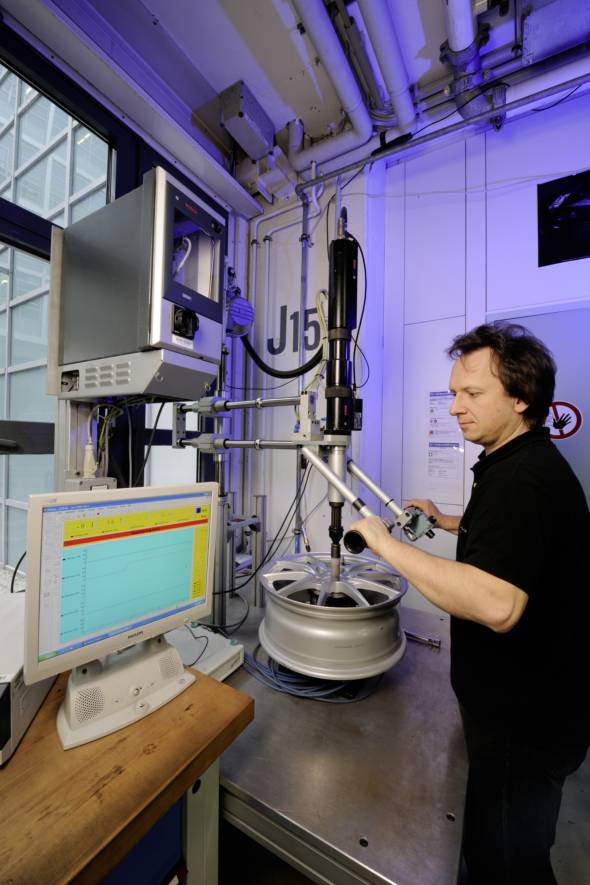
MercedesSport will initially be available for the E-Class family (Saloon, Estate, Coupé, Cabriolet) and then subsequently for other model series. MercedesSport items are available from authorised Mercedes-Benz outlets, including the option of fitting by qualified personnel.
A full range from Mercedes-Benz Accessories
Mercedes-Benz Accessories GmbH – a wholly-owned subsidiary of Daimler AG – is responsible for the development, selection and marketing of genuine accesso-ries and Collection products for the Mercedes-Benz, Maybach, AMG and smart brands. The product range includes accessories in various categories – refine-ment, telematics, complete wheels, wheels & tyres, protection & preservation, rack systems, comfort, safety and detachable body parts – as well as Collection products for merchandising and licences. The company employs over 200 people and is based in Stuttgart-Vaihingen.
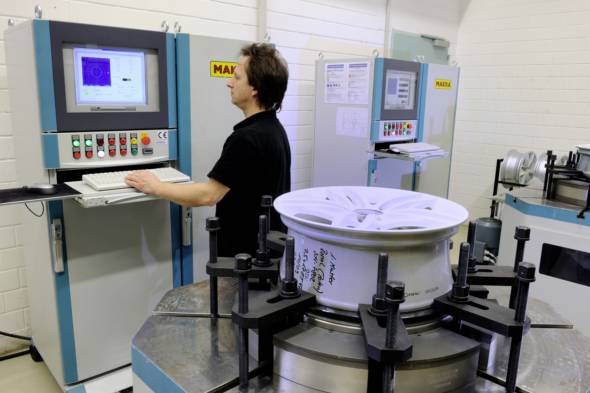
Cleaning up: care tips for light-alloy wheels
Cleaning tips and methods
There is one thing which the best development programme, the most innovative production technology or a perfectly tuned test programme cannot affect, how-ever: how customers treat their vehicles, and as a result their valuable light-alloy wheels. As always, how the wheels are treated has a significant influence on their value retention and also the safety of the vehicle.
Resistance to driving forces
It is a story which has featured in the media on an almost daily basis: after one of the harshest winters for many years, and due to a shortage of funds, the roads are now in a pitiful state of repair. Suddenly nasty pothole have appeared in roads which in the autumn were still for the most part relatively intact. Potholes are easily overlooked and are then therefore driven over at too high a speed. This can result in a heavy impact, which in extreme cases can damage both the wheel and the tyre. After encountering such an incident, drivers should stop briefly to check their wheel (and tyre) for any damage. In the case of visible deformation, for example a dent in the wheel rim flange, a more detailed check should be carried out by the specialists at the nearest Mercedes-Benz service centre.
Damaged wheels must be replaced
A light-alloy wheel which has suffered significant damage must be changed, even if many independent workshops are able to offer an inexpensive repair -such a step should be avoided at all costs. Mercedes-Benz light-alloy wheels are able to maintain their high performance thanks to the use of so-called “warm-storable aluminium alloys”. If a wheel is subjected to mechanical or thermal loads through welding, bending, flexing or grinding, the metal microstructure is likely to change in the treated area.
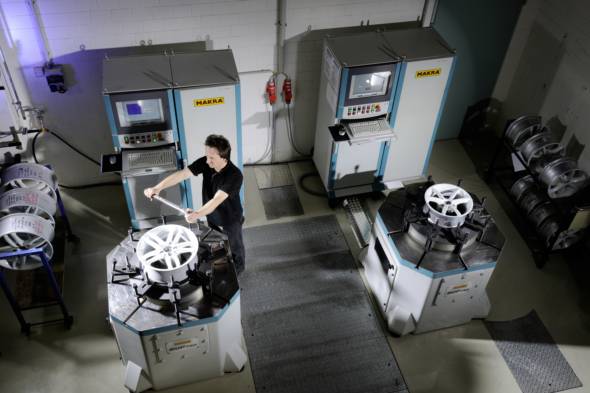
This can weaken the wheel at this specific spot, such that it is no longer able to achieve its original strength value at this point. In addi-tion, Mercedes-Benz wheels treated in this way no longer comply with the general certification for the vehicle. When repairing damaged paint finishes, only paints which harden when cold may be used. High-temperature bake-on paint finishes can also adversely the metal microstructure.
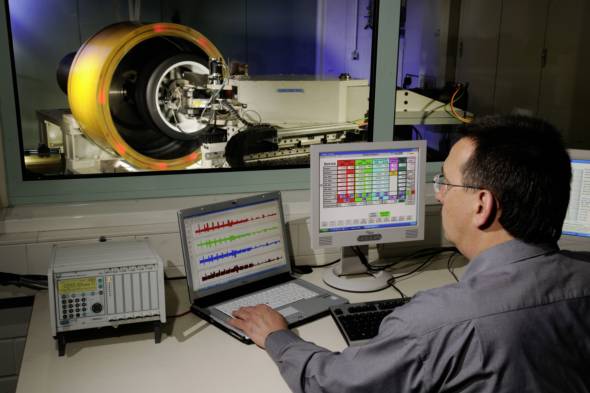
Correct wheel bolt connection is also just as important for ensuring the long-term operational life of a wheel and as such the recommended Mercedes-Benz wheel tightening torques should therefore be observed. Wheel bolts which are fitted too loose or have been applied with brute force can damage a light-alloy wheel. When tightening the bolts, it is also worth noting that the wheel bolts should not be oiled or have grease applied to them. This could cause the initial stress to be higher than the recommended tightening torque, resulting in damage to both the wheel and the bolts.
A lasting shine for light-alloy wheels
In spring, following the intensive salting of the roads which takes place in winter, wheels should be washed thoroughly to ensure that all salt residues are removed. This is particularly important when cleaning winter wheels which are to be stored during the summer.
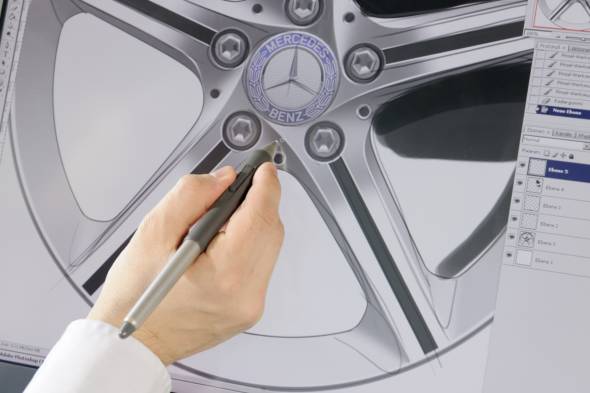
It is also advisable to gently and immediately remove any residues left on the paint finish. Natural chemical residues in particular, such as bird droppings or certain tree resins, should not be left on the wheels for long periods of time be-cause, despite the increased resistance of the clear coat, they can cause damage over the long term. Regular paintwork care and protection with special waxes can increase the resistance of the paint and help to make the removal of residues easier. The care system from Mercedes-Benz is highly recommended since the individual cleaning, care and protection agents have been designed specifically for the paint system used on wheels.
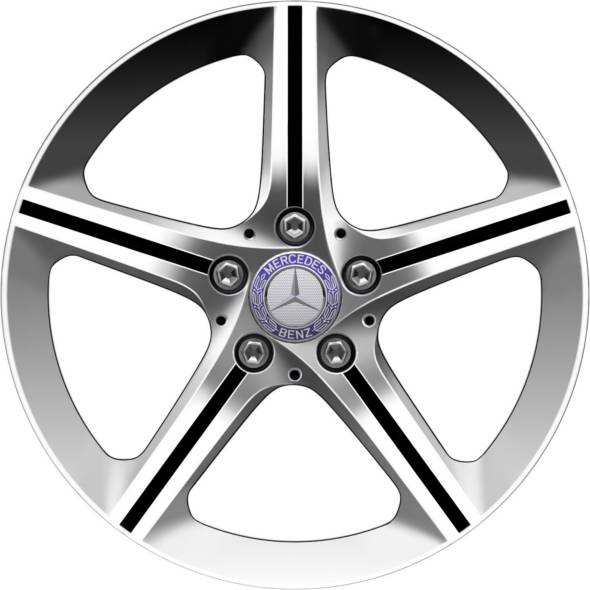
One important point to note: according to the latest research by the Mercedes-Benz paint development department, aggressive cleaning agents can attack the uppermost paint layers and damage the perfectly coordinated protection system. Rough, abrasive and harsh sponges should also be avoided when cleaning.Damage caused to the paint finish should always be treated so that the overall coordinated protection system can continue to be effec-tive. If immediate repair with cold varnish is not possible, it is recommended that the damaged area is temporarily sealed – especially in winter. Scratches can be covered with regular adhesive tape or a touch-up stick until a specialist from one of the Mercedes-Benz support centres has examined the damage and arranged any necessary repair or replacement.
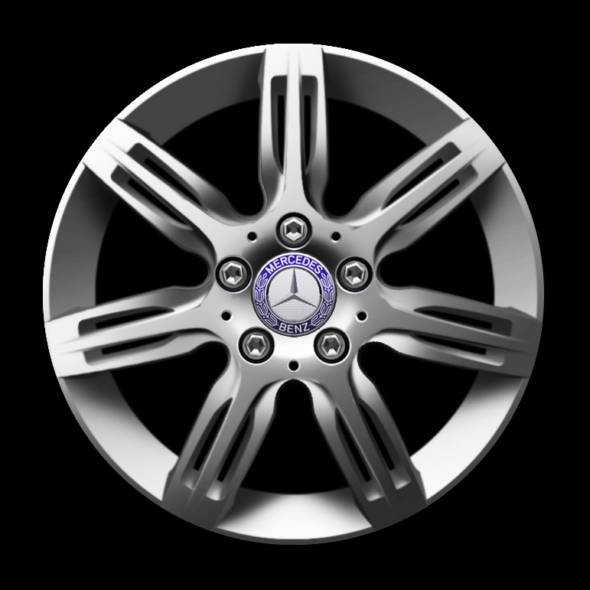
Observe the regulations relating to wheels
Light-alloy wheels from Mercedes-Benz are extremely durable. It is not for nothing that the test specifications for new wheels at Mercedes-Benz significantly exceed the statutory requirements. Their high performance is linked to specific conditions which must be complied with. As a result, the wheels should only be fitted with tyres of the relevant approved sizes. When driving with a heavy load, for example when going on holiday with a lot of luggage and towing a caravan or sports trailer, the tyre inflation pressure should be increased in accordance with the details indicated in the owner’s manual, and at the same time the permissible wheel loads should not be exceeded. A summary of care tips and methods:

The wheel of its day: a light-alloy classic from Mercedes-Benz
Baroque wheels and manhole covers
Light-alloy wheels such as the high-sheen two-tone variants, or the weight and airflow-enhanced standard wheels of the BlueEFFICIENCY models, currently represent the culmination of development which began in series production Mercedes-Benz vehicles as early as 1970. Up until that time, steel was the material of choice when it came to making wheels. Alternative materials such as aluminium, for example, were only used – if used at all- in motor racing and for specific prototypes such as the C111. The breakthrough into series production came at the end of the 1960’s, when new metal alloys and production methods found their way into large-scale production.
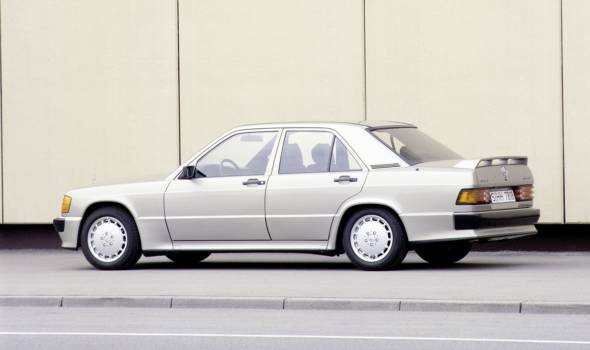
When the first light-alloy wheel came onto the market at the start of the 1970’s, the Mercedes-Benz model range was very well-organized. The predecessor to today’s E-Class was called the “stroke eight” and was the bestseller, accompanied in the range by the S, SE and SEL luxury Saloons, Coupés and Cabriolets, and the SL, SLC and 600 Roadster family. The model series were not so varied as the vehicles of today’s diversified product selection, which comprises models ranging from the small A/B-Class, through the Saloons of the C, E and S-Class, right up to the medium and large SUV’s of the R, GLK, M or GL-Class, as well as such sporty highlights as the SLK Roadster series and the new SLS gull-wing.
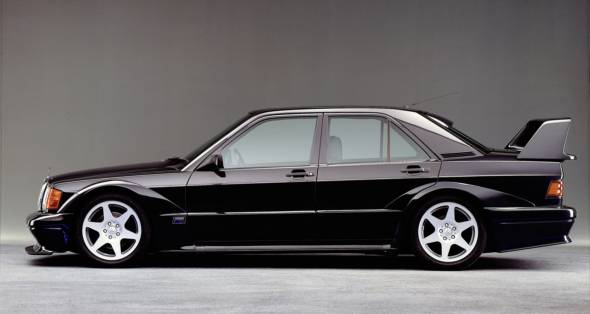
Given the early, well-organised model range, at the time it was sufficient to have just one wheel model made from the new material which could be made available for all model series. Initially Mercedes-Benz started off with forged aluminium wheels from the renowned manufacturer Fuchs, a company also famous for pro-ducing the five-spoke wheels with matt-black painted wheel braces and silver wheel rim base for the Porsche 911.

The “premiere wheel” was the first to become available as an optional extra for the 280 S to 300 SEL 6.3 W 108 series Saloons, available in the sizes 6J x 14 and 6.5J x 14, and was later christened the “baroque wheel” on account of its ornate design. Up until the mid-1980’s the “baroque wheel” was the Mercedes-Benz light-alloy wheel par excellence and became inextricably associated with the brand.
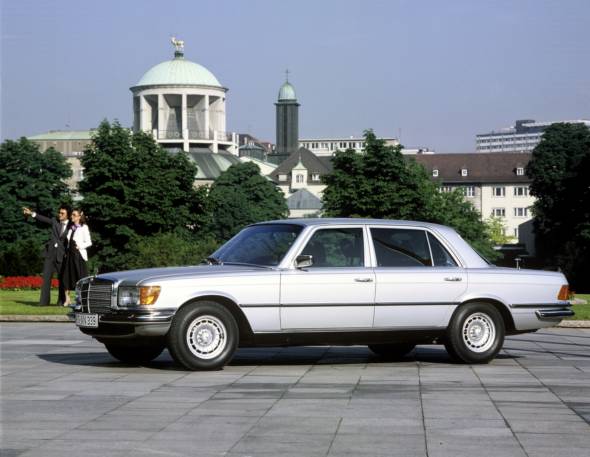
After this initial foray into the world of light-alloy wheels, the range continued to be expanded. For the 190 compact model series and models from the 200 to 300 E mid-size model series, the 20-spoke light-alloy wheel first appeared in the size 6J x 15 in the accessory catalogue from the mid-1980’s, which thanks to its characteristic wheel disc shape soon earned the nickname the “police star wheel” and to some extent is considered to be the first work of Mercedes-Benz Accessories. The final triumphant move came in the same decade in the form of the legendary “manhole cover wheel”. Today, with a few exceptions, almost all of the series production vehicles from Mercedes-Benz run on light-alloy wheels.
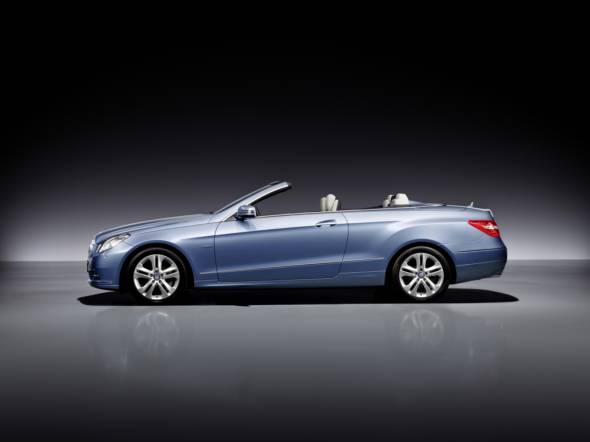
How successful light-alloy wheels have been is reflected in the following compari-son: around 4600 examples of the “baroque” model were sold each year at the start of the 1970’s. In 2009, the majority of new Mercedes-Benz vehicles were on “alloys”. Together with the sales figures from Mercedes-Benz Accessories, the number of alloy wheels brought into circulation has increased to around 4 million per year.
